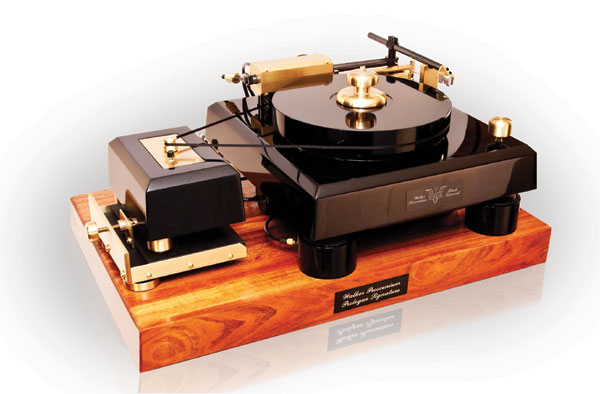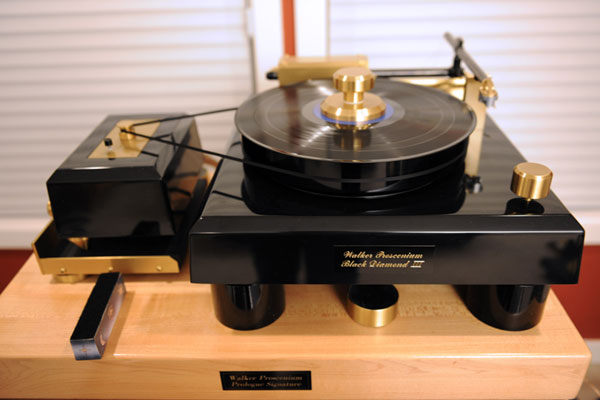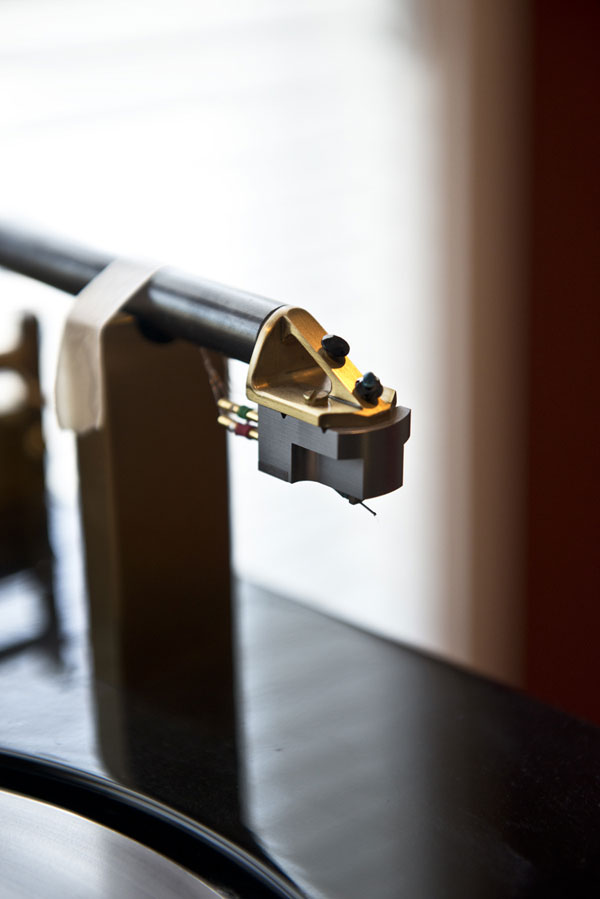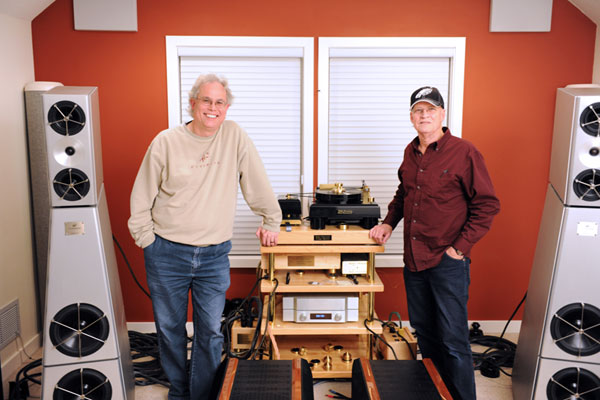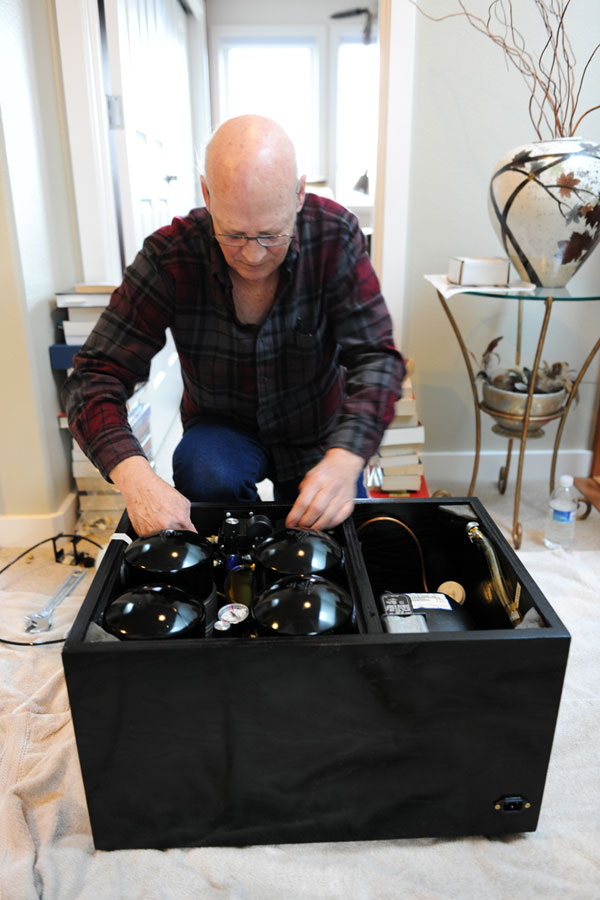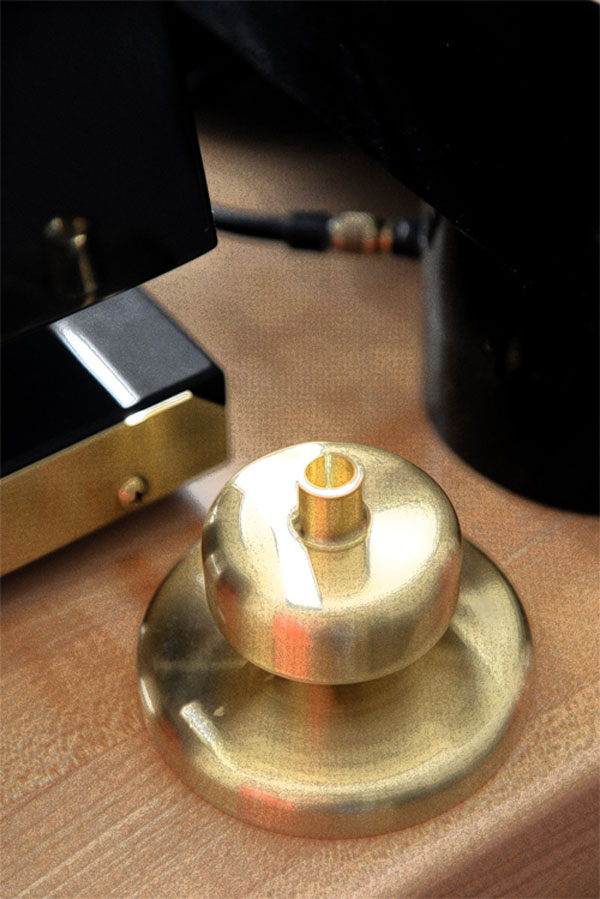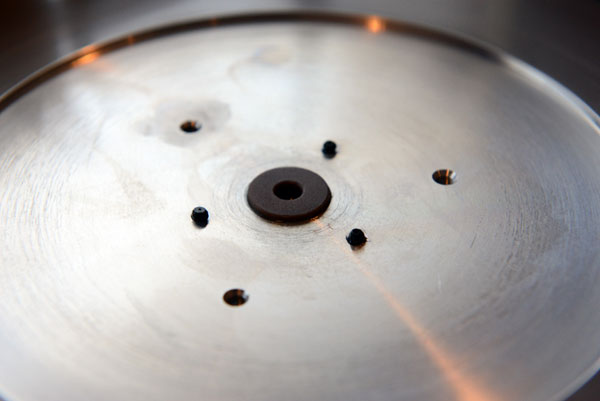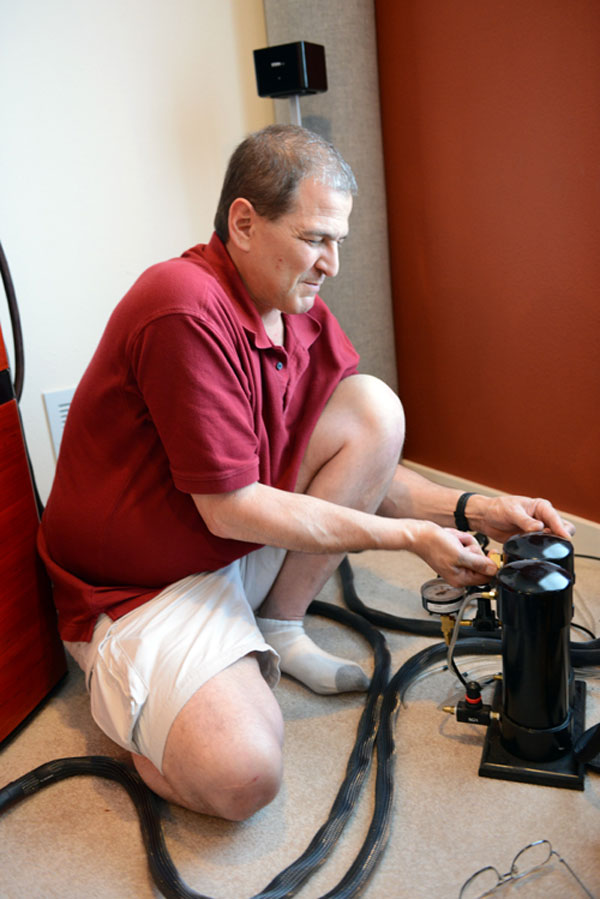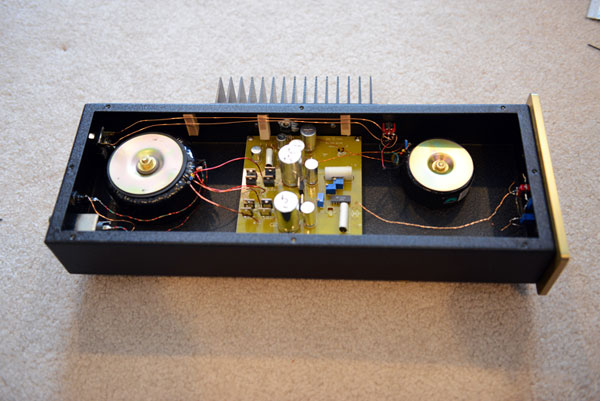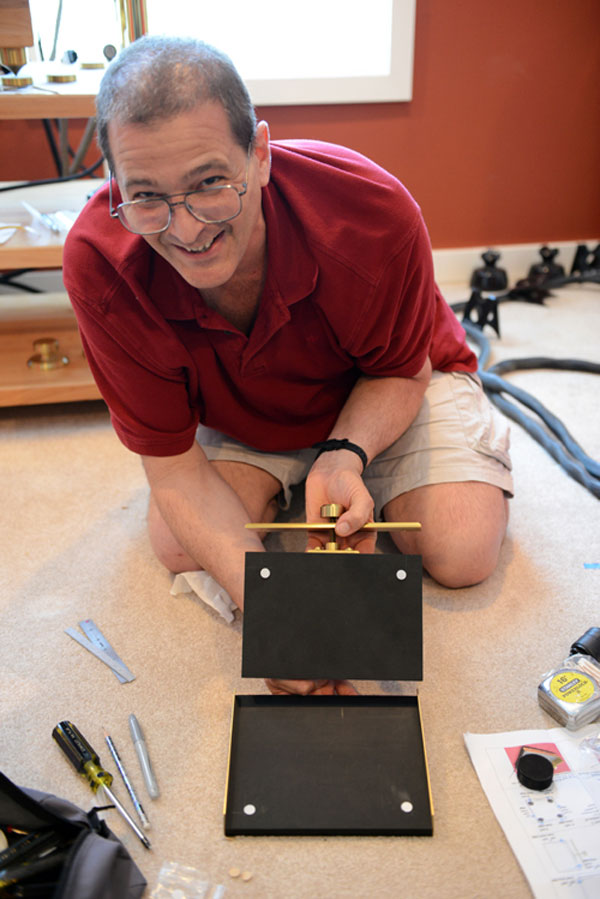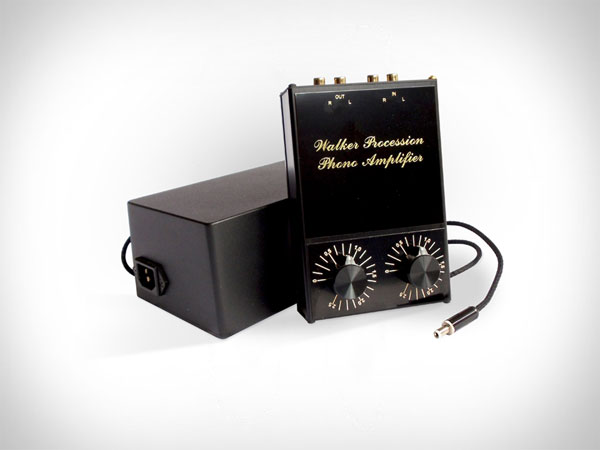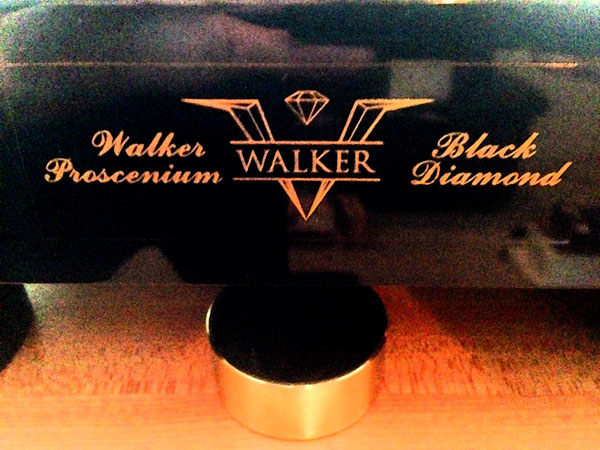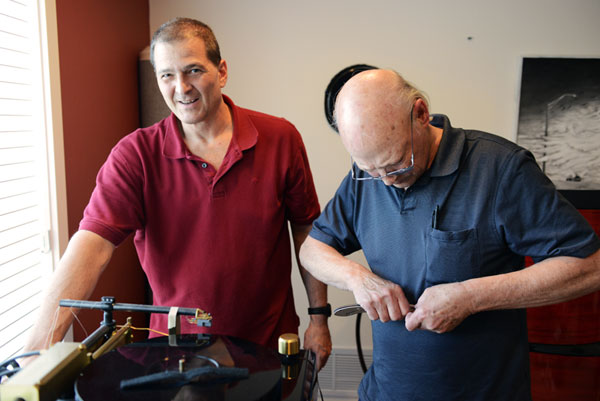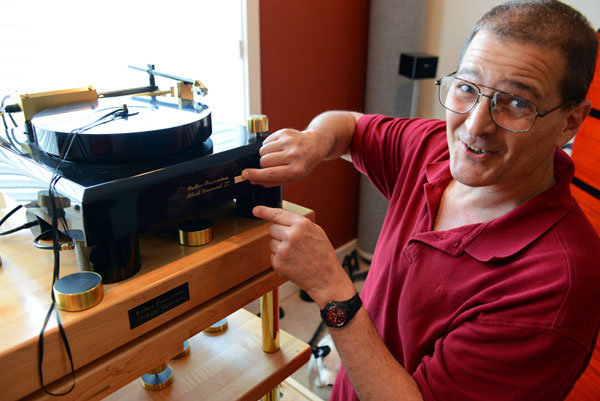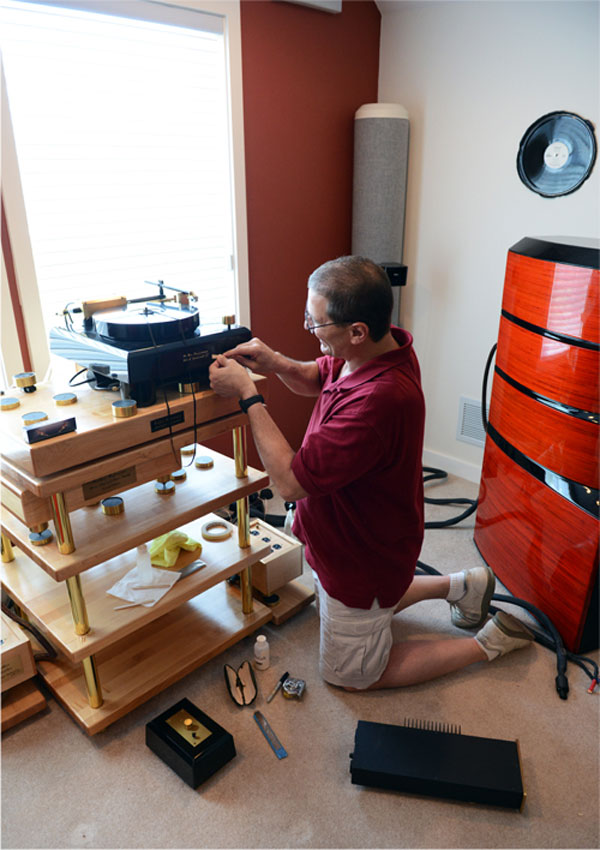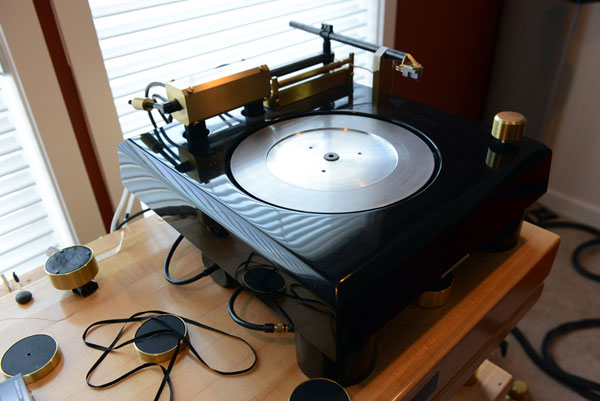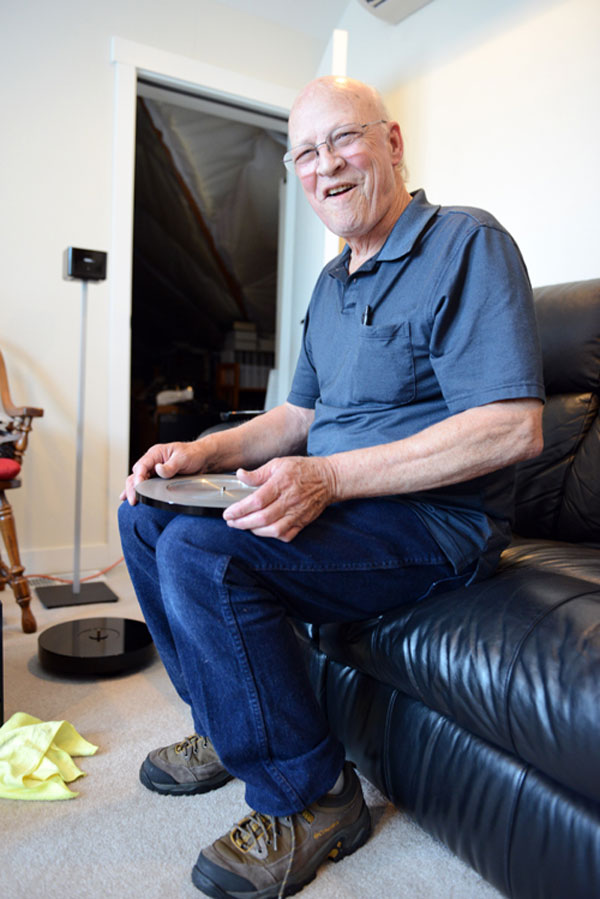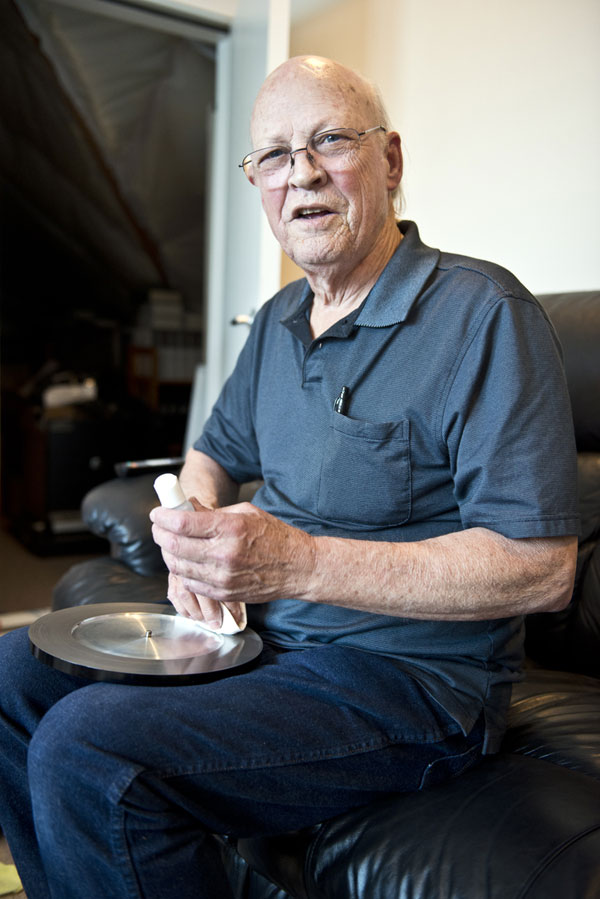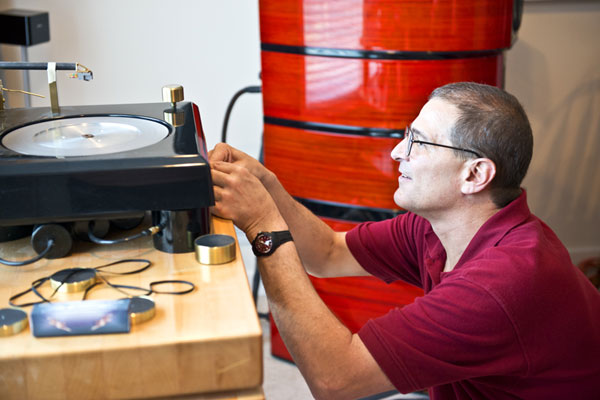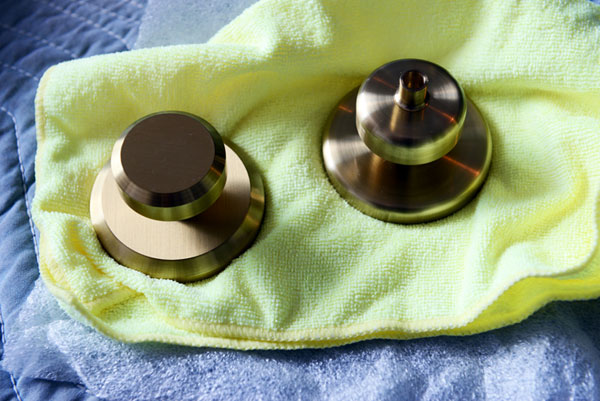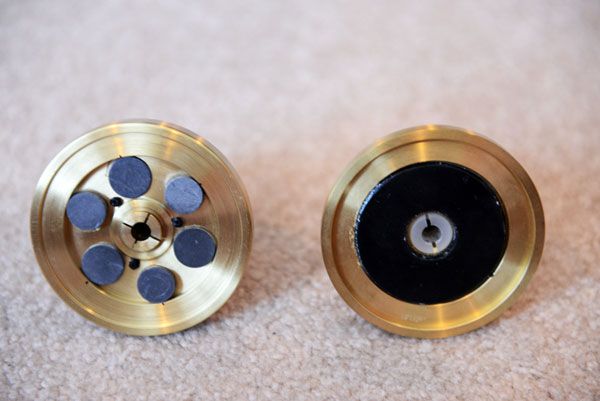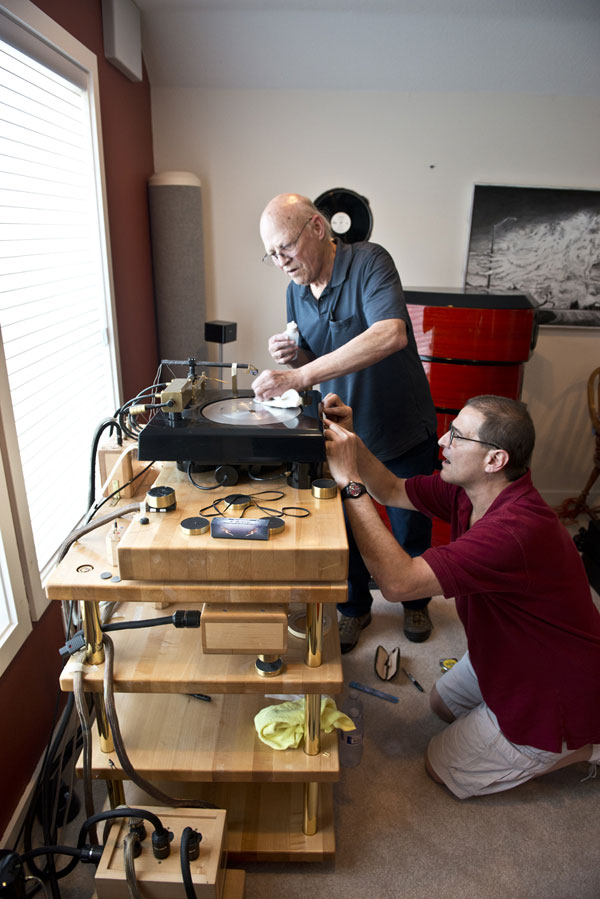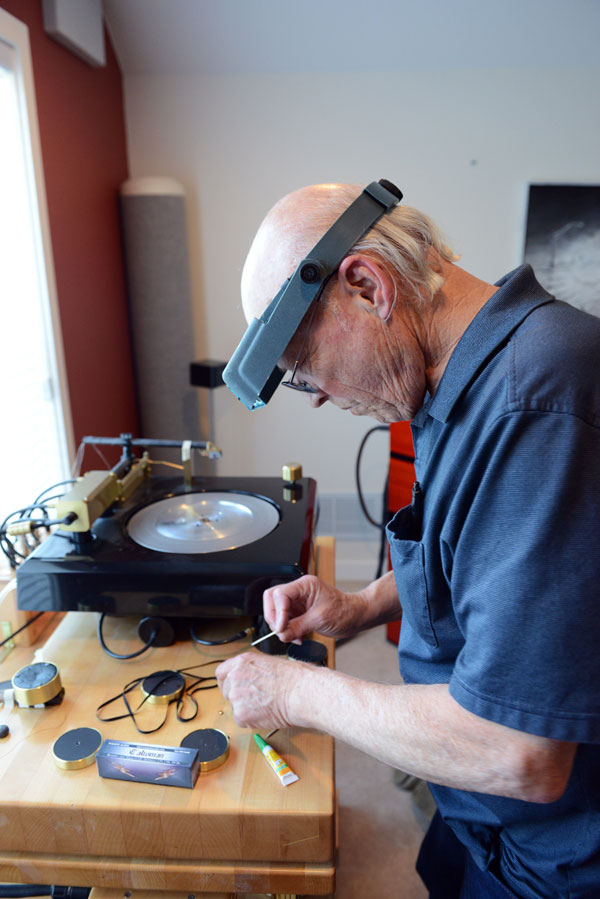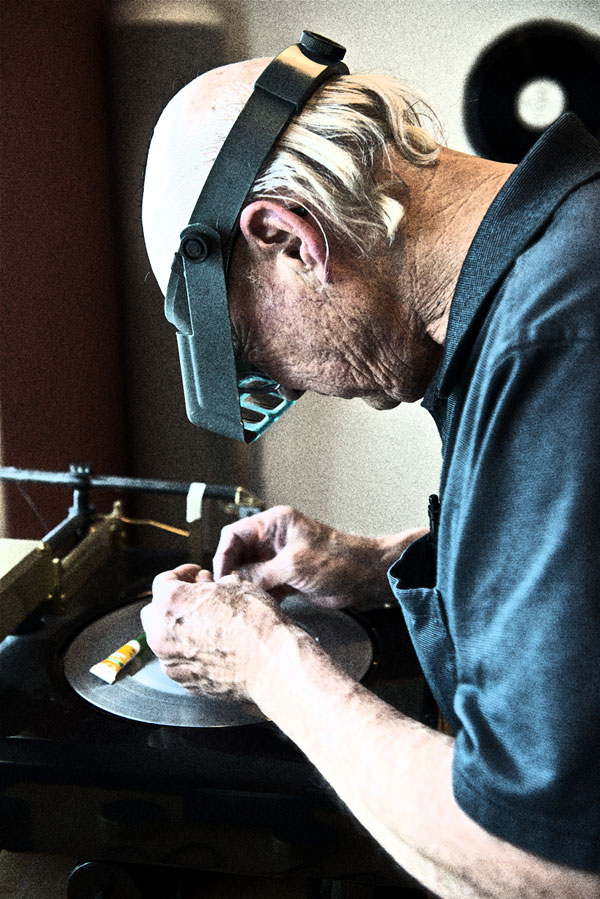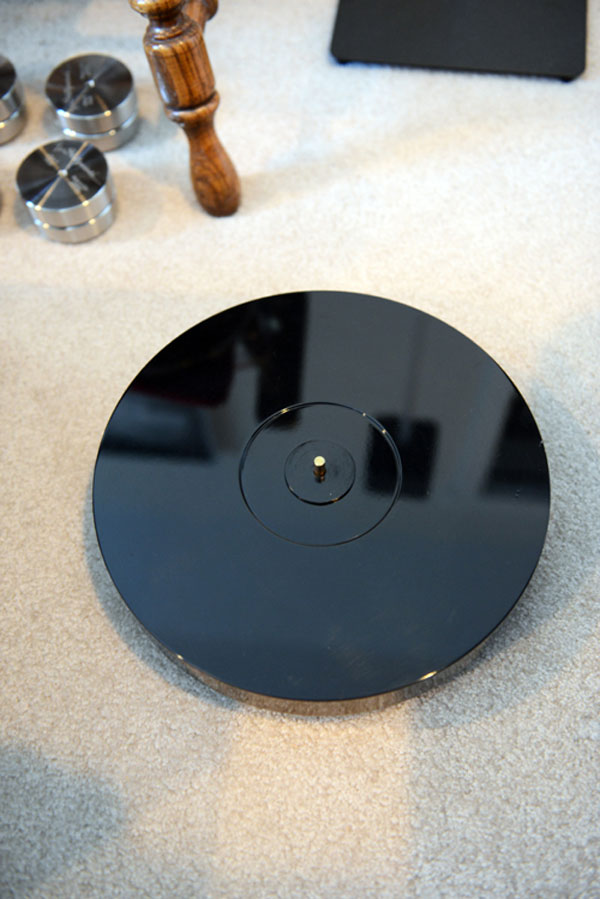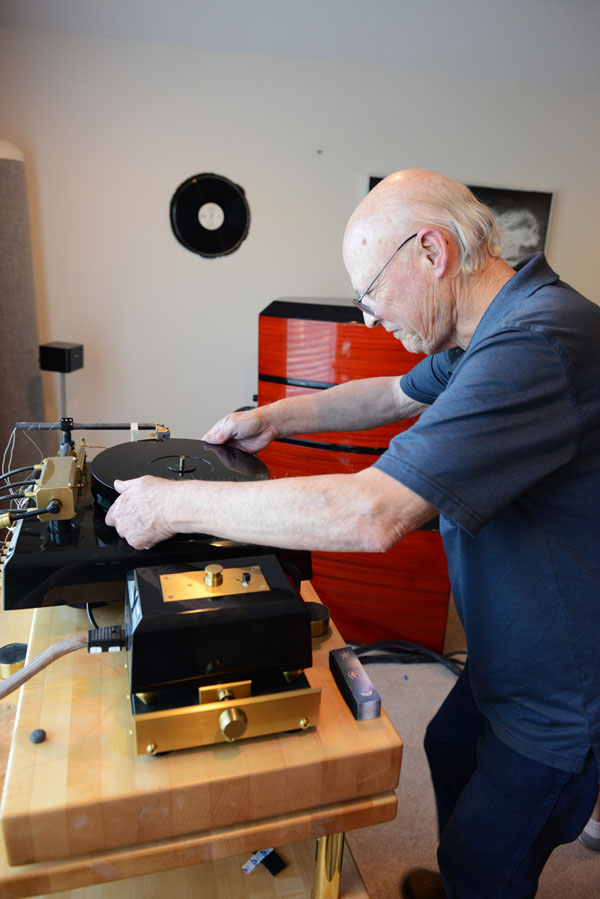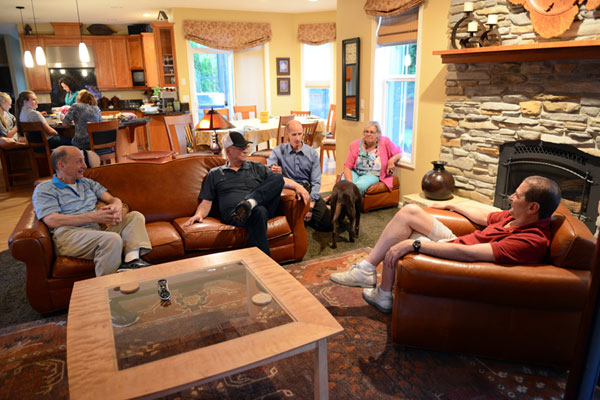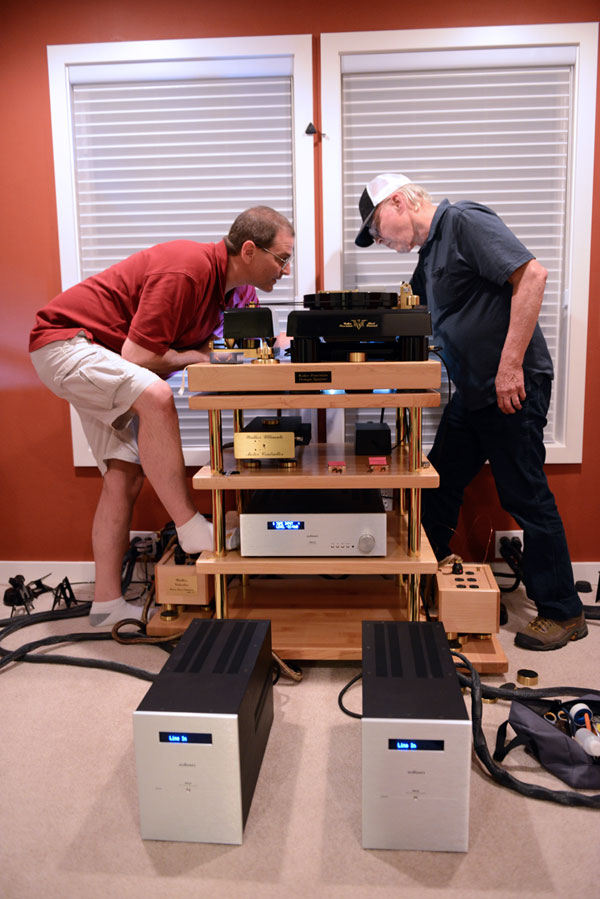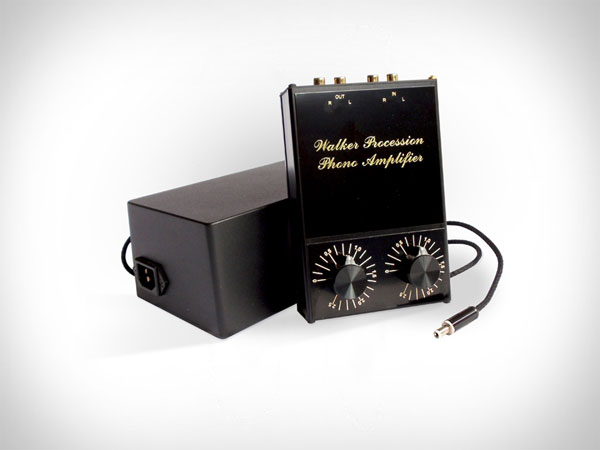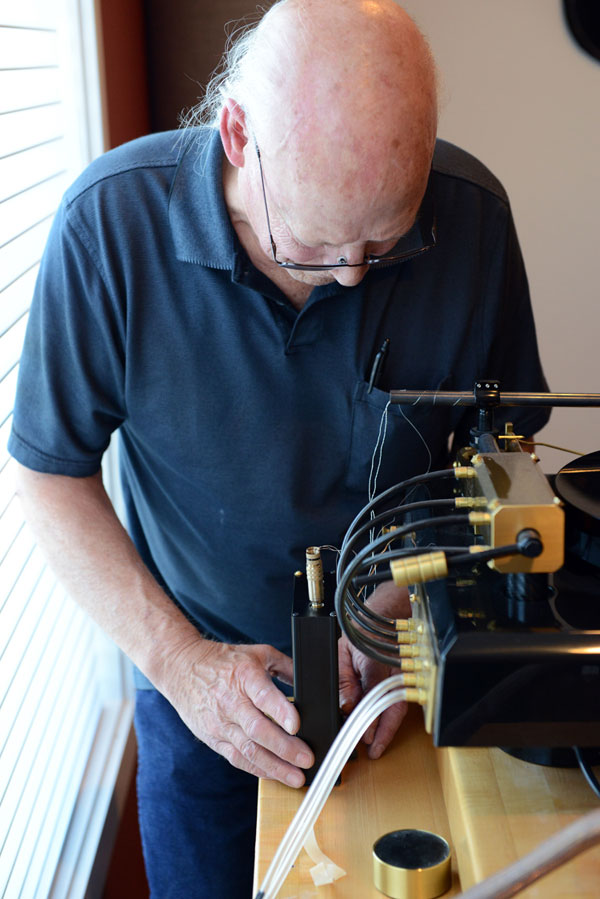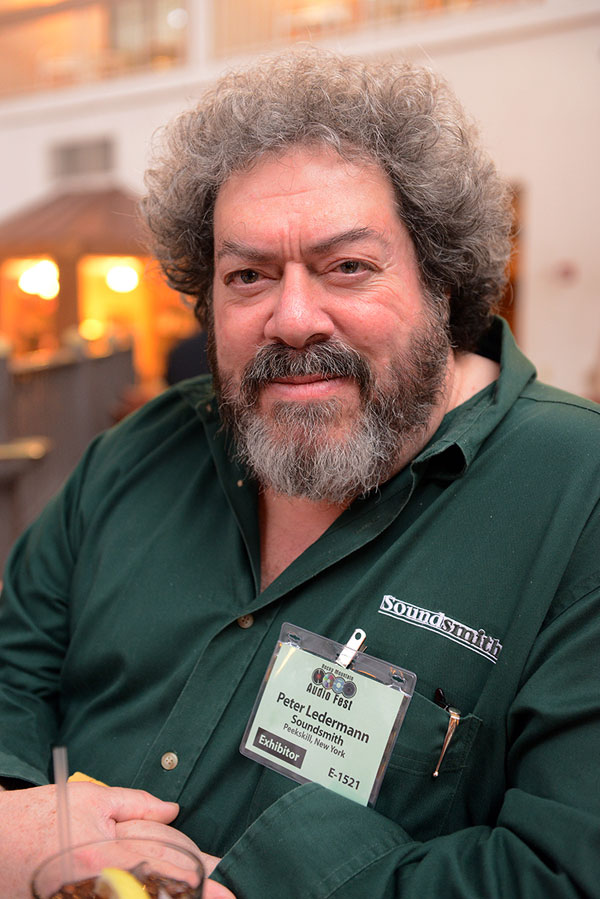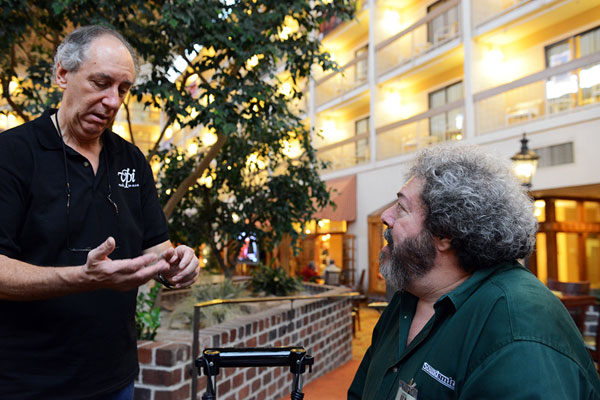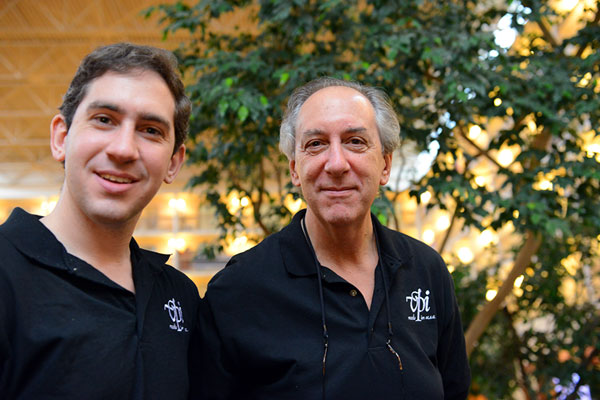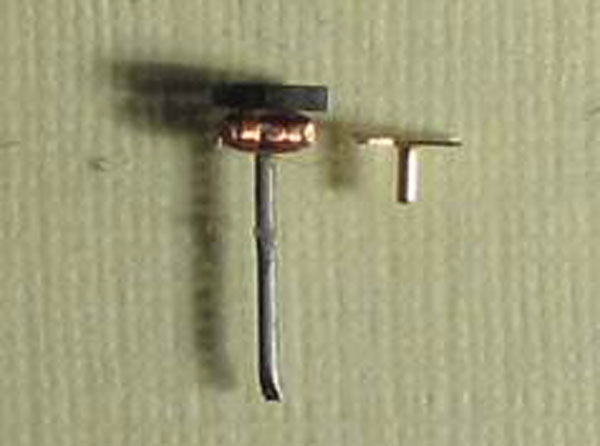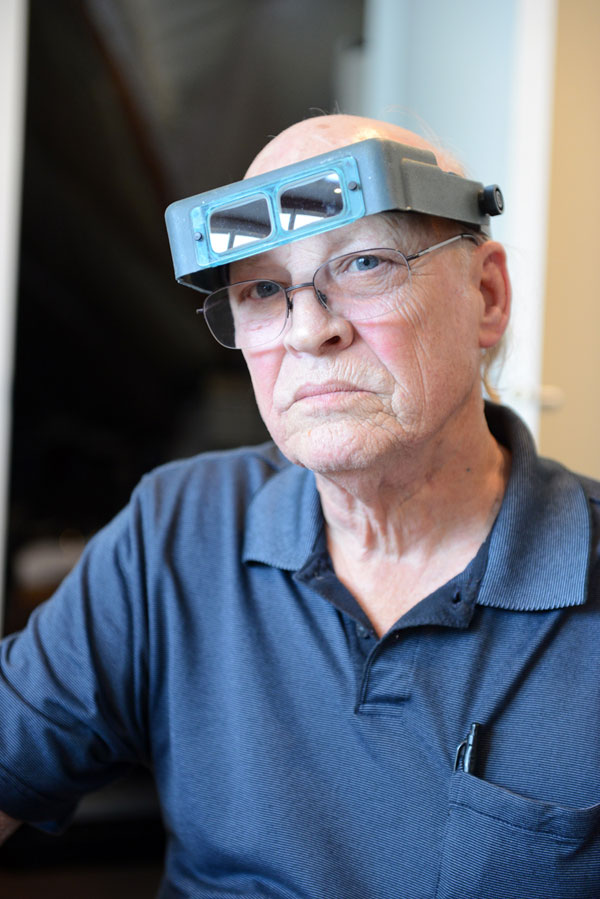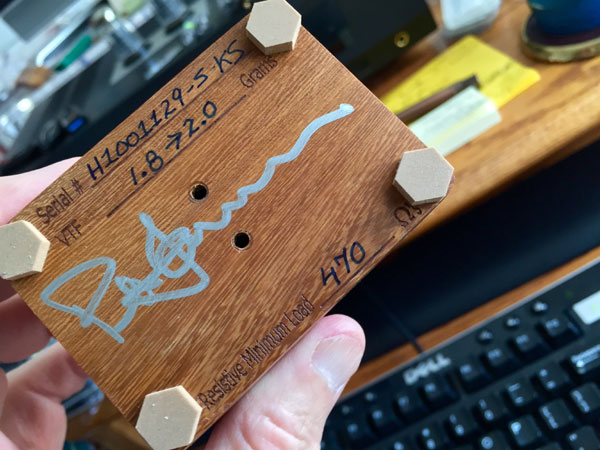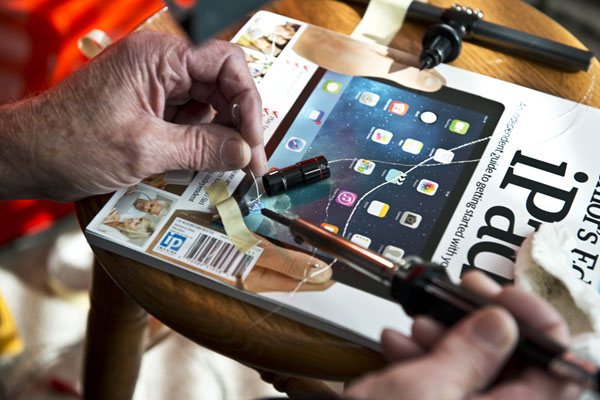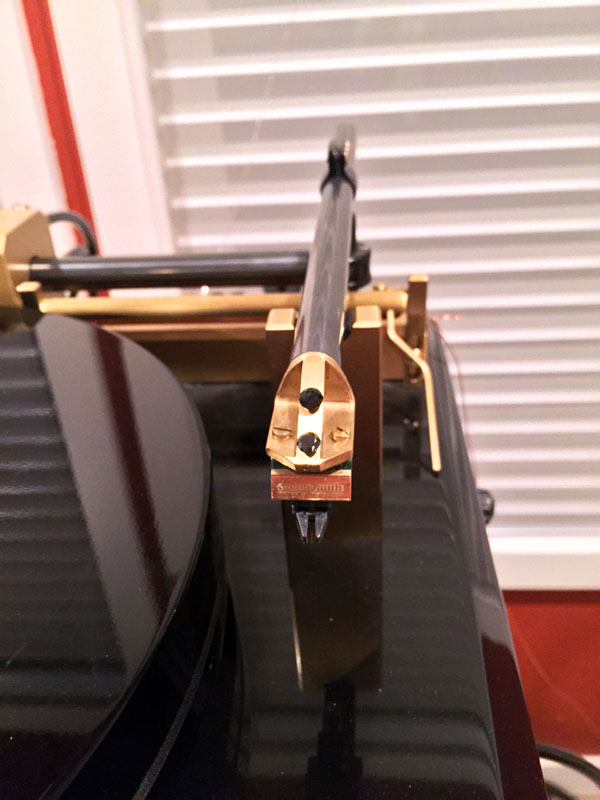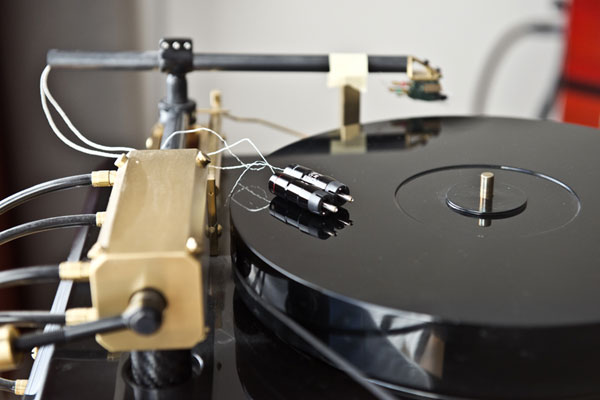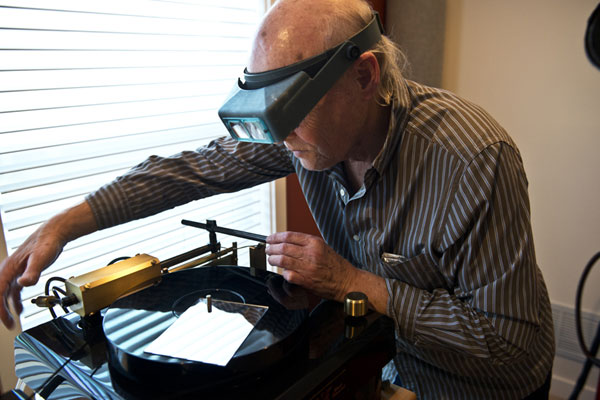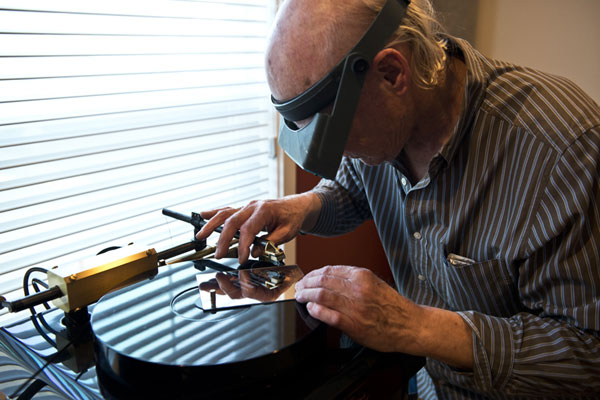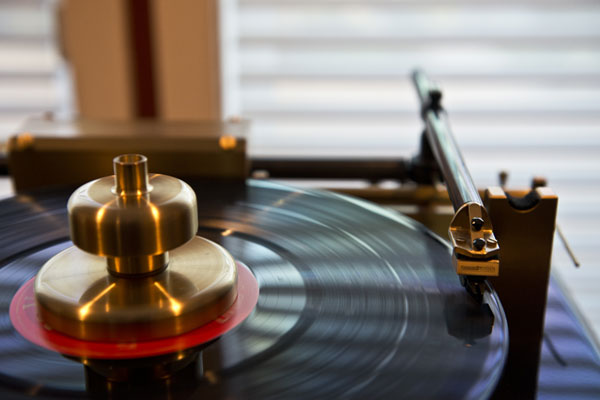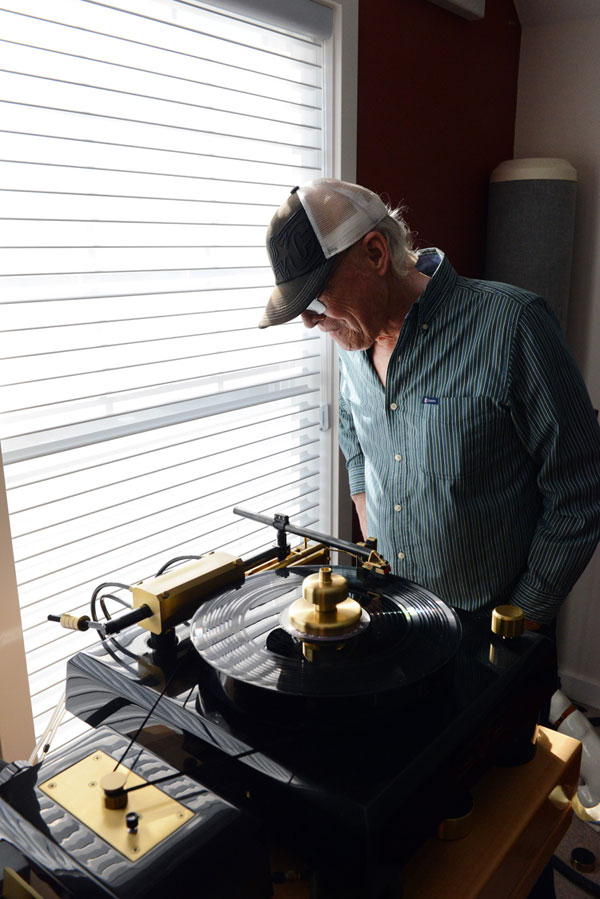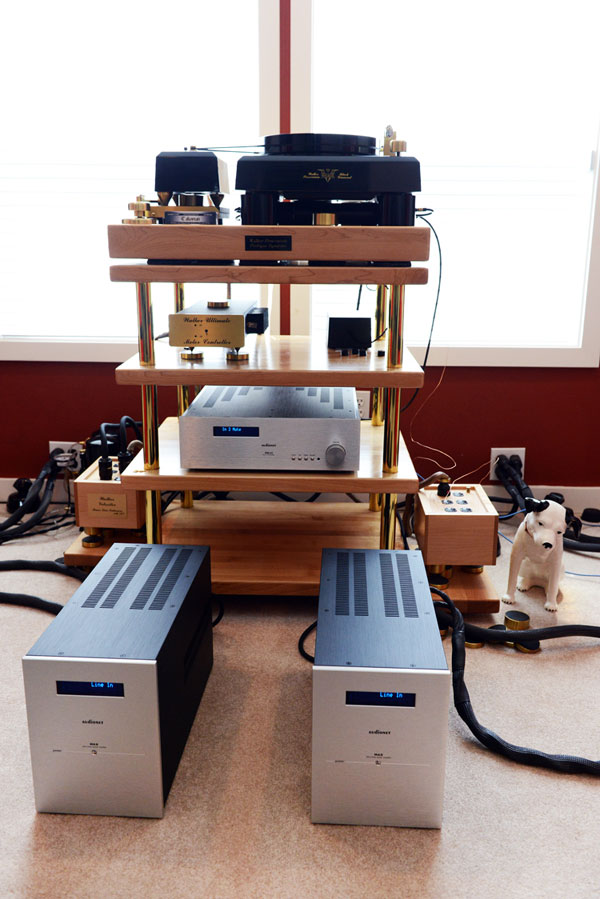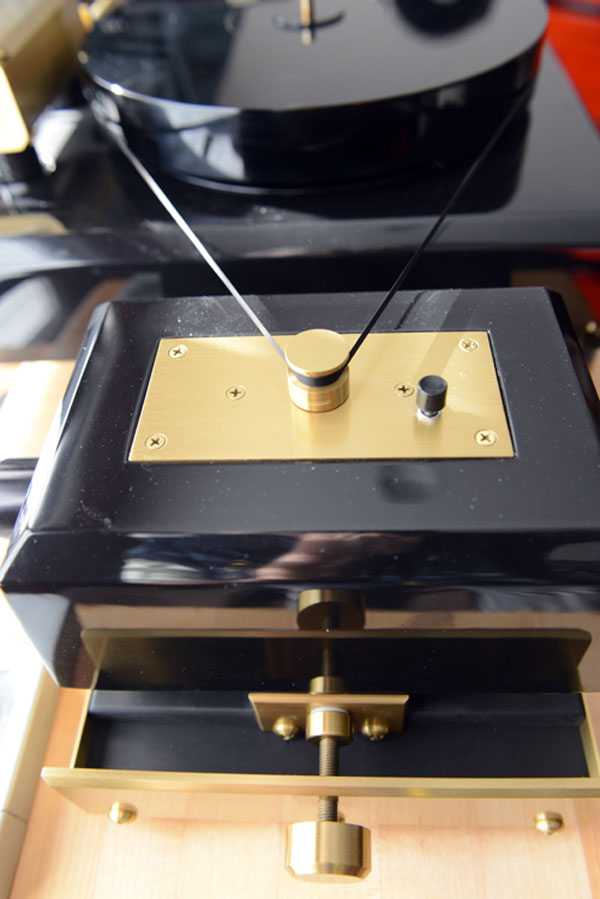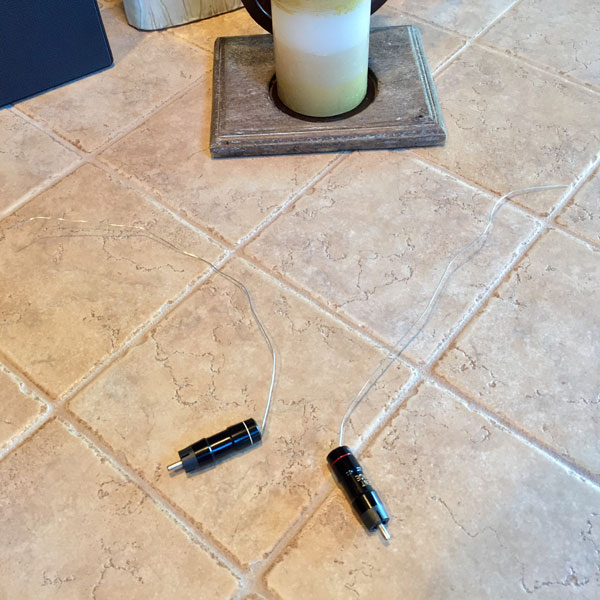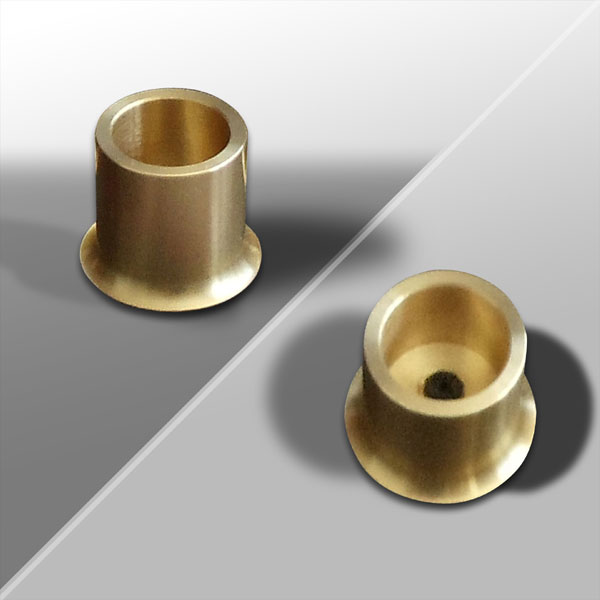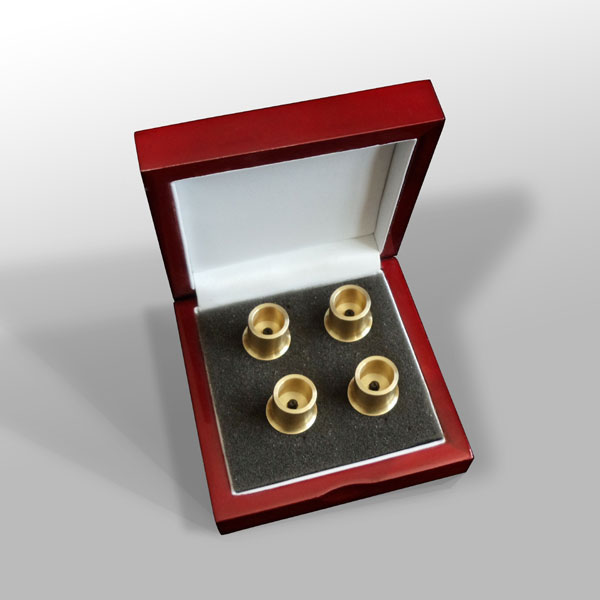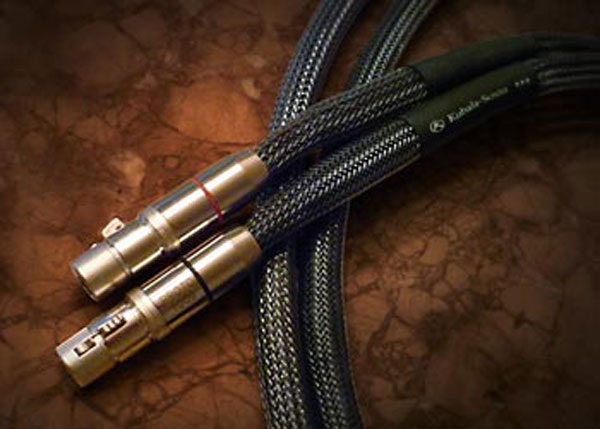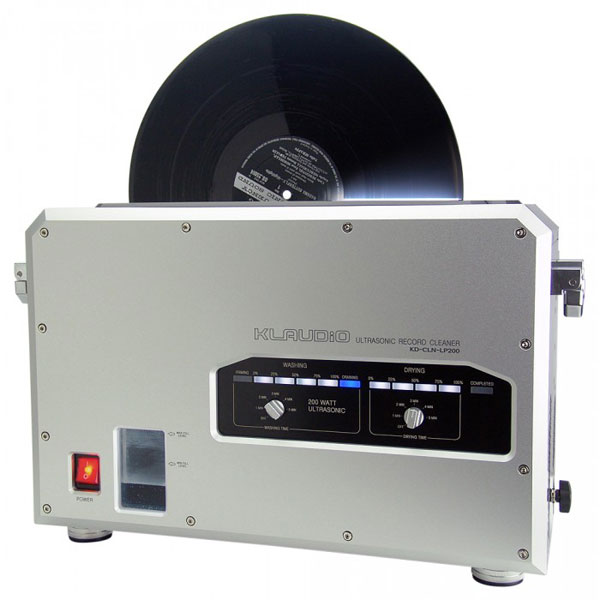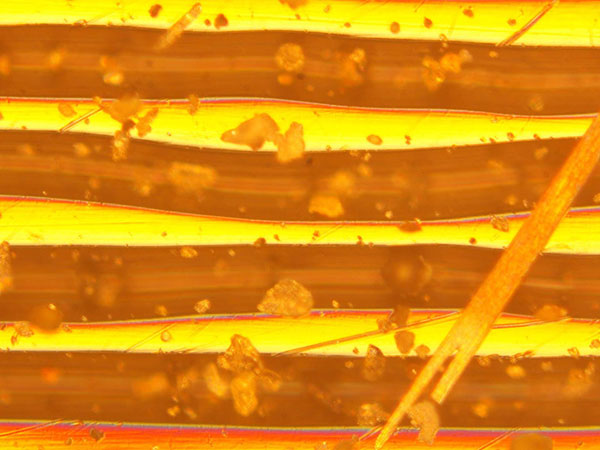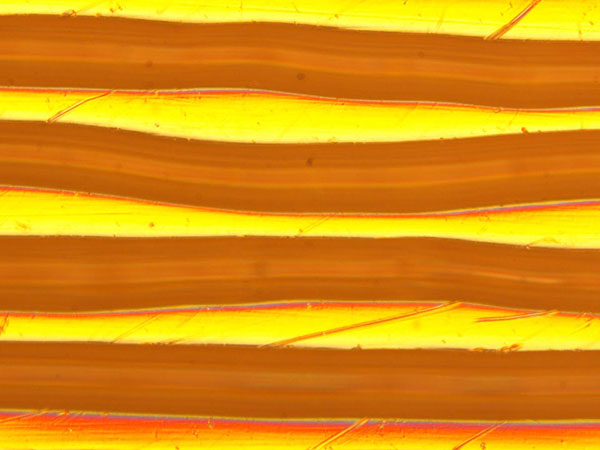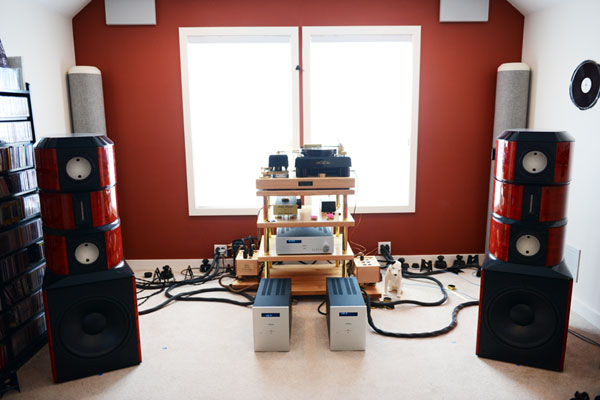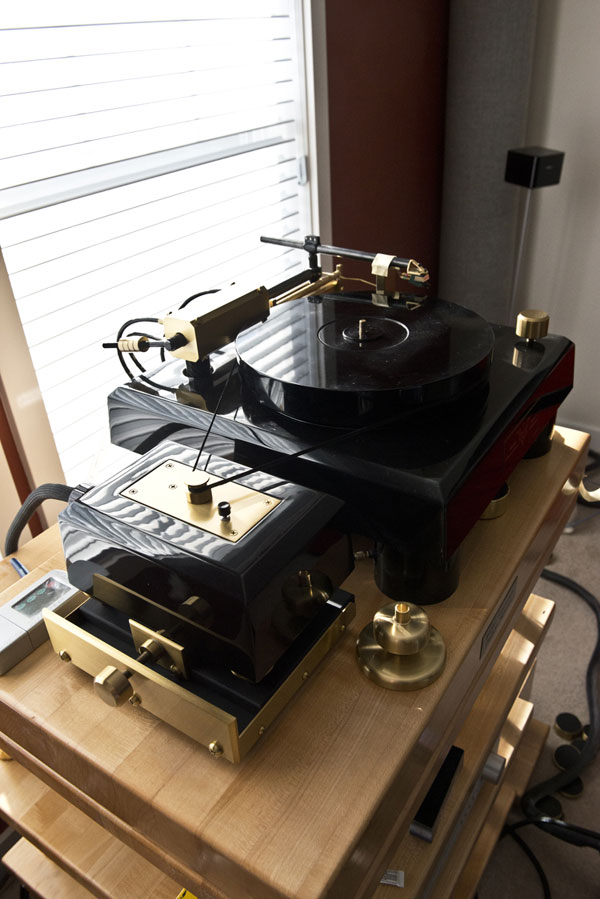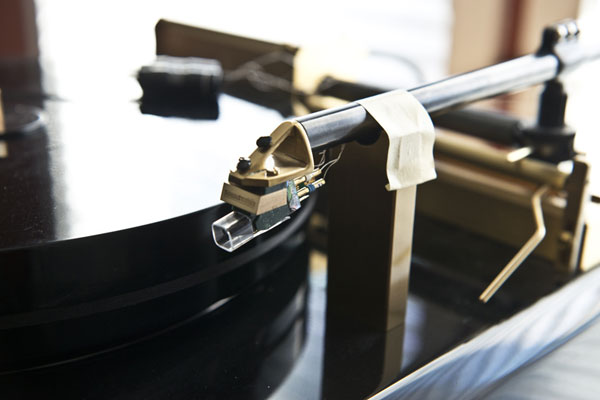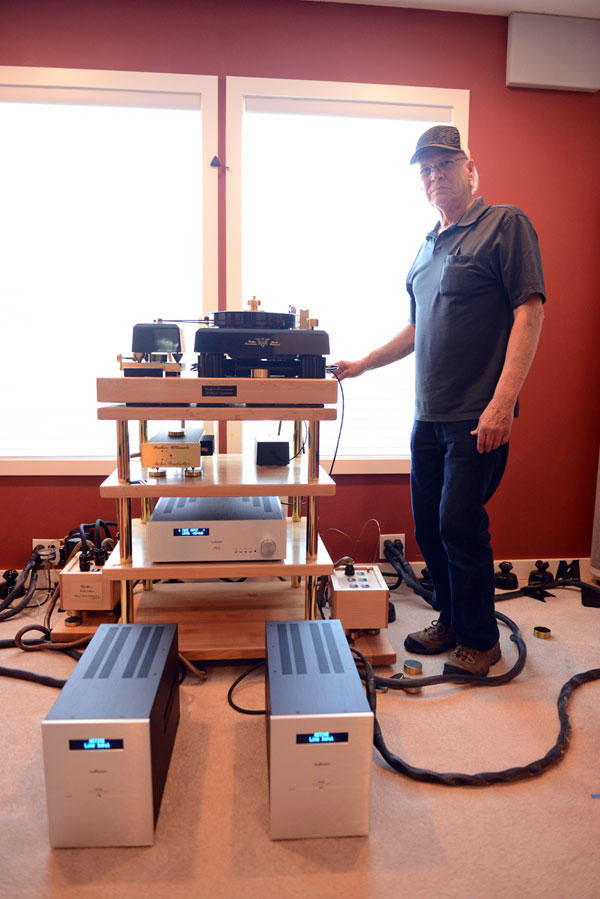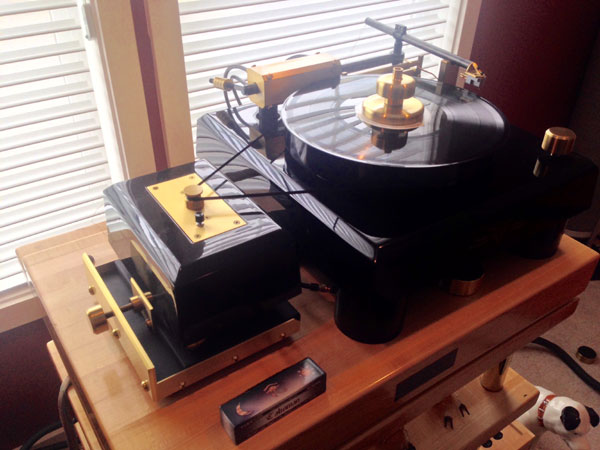You are reading the older HTML site
Positive Feedback ISSUE 78
Impressions: The Walker Audio Proscenium Black Diamond, Level V,
Walker Audio Procession Phono Amplifier, the Walker Audio
Eliminator, Room Crystals, and the Soundsmith Hyperion MI Cartridge
(plus a supporting cast!) – a photo essay [Photographs and image processing by Robinson, unless otherwise noted]
The Walker Audio Proscenium Black Diamond Level V Reference Turntable [Photograph courtesy of Walker Audio] Slow train comin'… First things first. Those of you who haven't already read my extensive review of the Audionet reference system elsewhere in this issue (HERE) need to stop right here, go to that essay, and complete it before going on with this one. It will give you a sense of the system setting for this evaluation, and will also show the audio framework in which the upgrades to the Walker Audio Proscenium Black Diamond Level III took place. There's a lot of (good) crosstalk that occurred between these two major projects…best to read my notes in sequence, as two large parts of a single nine-month project. Because that's what it was. Those of you who are new to the Walker Audio Proscenium turntable will benefit from reading my earlier comments on this world-class reference. These include my initial comments in Issue 19, extensive comments in Issue 23, with supporting screams of joy and amazement from Rick Gardner in that same issue (HERE), Issue 35, and Issue 58. This is in addition to the accolades that I've given the Proscenium over the years in various Brutus Awards. In other words, I've had a pile to say about this turntable over the years. But now I've got to warm up my keyboard again, because there are major new developments on the Walker Audio front in our reference system. There's so much to cover that I'll need to break down my summary and impressions into a set of smaller steps, proceeding in the order that the work was done. Along the way, I'll be talking about some of the system enhancements that Lloyd Walker has developed, and that we installed into the listening room. They're definitely a part of the picture, and essential to the final result that I experienced.
The view from 2011: The newly upgraded Proscenium Black Diamond, sitting at Level III
My old MC: The MicroMagic Magic Diamond in place on the Proscenium Level III Upgrade time By June of 2014 it had been more than two and one-half years since the last major upgrade to the Proscenium, to Level III, back in 2011. It had been a great update at the time. Among other things, Lloyd's Level III upgrade added a second set of down-line pressure chambers with a split air supply feed to the plinth and tonearm. A second pressure gauge with a different pressure setting for the second feed is part of that upgrade. (Mine is currently set to 20.9 psi.) Lloyd improved his reference phono amp internally, installing new components, and re-worked the main air pump system. Level III was certainly a step up from the earlier Gold Black Diamond…it took a Brutus Award in 2011.
David Robinson and Lloyd Walker, November of 2011, right after the completion of the Level III upgrade But Lloyd Walker never rests; two years plus is a long time with him. As the years followed, Lloyd and I would talk periodically, and he would tell me what he was up to. I would try his system enhancements from time to time, always with good effect in my listening room. The innovations that have come from Walker Audio are of a particular kind, the sorts of things that you'll design when you listen, when you notice things, and when you're willing to work hard to produce that next little bit of improvement. In fact, Lloyd reminds me of Bobby Palkovic of Merlin Music, who is the same way with his speaker designs…always getting those next few percentage points out of designs that you were sure were as good as they could be. And then they get better, leaving you shaking your head. That's Lloyd.
Lloyd Walker at work at PF Central on upgrading the Proscenium's main air compressor system to Level III, November 2011 It had been over two years since the Level III upgrade when Lloyd got in touch with me in the spring of 2014, saying that he'd like to take the Proscenium up to the latest revision, Level V. Was I interested? You think? The results, he promised, would be a huge step forward. The Level V upgrades would involve several tasks, which Lloyd summarized as follows: First, the head shell on the Proscenium tonearm would receive two 4mm Black Diamond crystals. These crystals have 58 facets on each. When stimulated by RFI/EMI, the crystals generate a negative voltage to cancel it, and give off negative ions (which are thought to have positive effects for our health according to some studies.)
Second, the old Walker Audio record would be replaced by a new record clamp. The new Walker Audio record clamp is re-tuned to control vibration and resonances in the LP. Three Black Diamond crystals face downward to cancel RFI and help eliminate static on the LP. A special 3mm clear/white faceted crystal is inside the top cup of the clamp, facing upward, and shielded on the sides within the cup to cancel electrical noise above the LP.
The mounted Black Diamond Crystals (small black units) in place on the bottom half of the Proscenium's air-bearing platform Third, on the bottom half of the air-bearing of the Proscenium are three more Black Diamond crystals that are bonded to the inside of the lower air bearing to treat the air inside, thus reducing static electricity.
Fred Law modifying the secondary air chamber system with a Black Diamond Crystal Fourth, the air supply to the arm has a special small-flow chamber containing another special black crystal to condition the air for the arm.
The Walker Audio Ultimate Motor Controller, open for the installation of a special Black Diamond Crystal Fifth, a black crystal is also placed on the power transformer in the motor controller, to reduce electrical noise in the unit.
Fred Law working on the platforms for the Proscenium motor drive system Finally, a new synthetic treatment for the air-bearing surface of the platter (underneath) is used to allow lower air flow for the platter.
The new Walker Audio Procession phono amp, with its dedicated power supply; note the continuously variable loading, from 0 to 2.5K ohms. [Photograph courtesy of Walker Audio] In addition to these changes, Lloyd also told me that he had a new reference phono amp that was way ahead of his old phono amp. Called the Procession, it was, in fact, in a whole new league, he said: Well beyond the Level III version of the old reference phono amp. It was also noticeably smaller, being more compact, lighter, and sporting a new dedicated power supply. Now there was no way that I was going to miss hearing that, since I was a big fan of Lloyd's older preamp, and so he promised me that he would bring one along. Everything after that was simply a matter of scheduling. Since Walker Audio was going to be at THE Show Newport Beach in June, 2014, Lloyd suggested that he and Fred fly up to Portland on the Monday immediately after that event was over. We could dig in on the project in a crash day, and then they would fly home. Done deal.
Moving to Level V As I pointed out in my Audionet review, doing this project immediately after THE Show Newport Beach was really pushing it. Lloyd, his colleague Fred Law, and I were all tired from the previous four days. The Audionet gear was stone-cold new, having arrived just before I left for Newport Beach, with the exception of their PAM G2 reference phono amp. It had mileage on it thanks to Bill Parish of GTT Audio, who had been using it as a demo. The rest was direct from the factory. All that I could do was fully warm it up while Lloyd and Fred dug in. It's always impressive to watch these two in action!
Fred Law and Lloyd Walker in action… Given the limited time that Lloyd and Fred had, they dug in on the turntable immediately.
Fred Law digging in on the disassembly of the old Proscenium Level III system
Ready for the redressing of the subsection, and the application of Black Diamond Crystals The fact that the platter suspension pressure was going to be lowered somewhat for the sonic benefits meant that the massive 75 pound platter had to be removed and the Proscenium redressed with a different finishing compound. This would allow for tighter tolerances after the upgrade was completed.
Lloyd Walker readying the Proscenium subsection for re-dressing Given the prodigious weight of the Proscenium platter, this was no small task. Fred exerted considerable elbow grease to hoist it carefully, and then place in on the carpet. (You can see it in the background of the photograph above.) Lloyd then took the subsection of the Proscenium out for redressing, and the application of the Black Diamond Crystals.
Lloyd in the midst of the application of the new compound for the subsection
Fred Law affixing the new Proscenium Level V faceplate The amount of effort involved was considerable; hours went by. If the earlier upgrade to Level III in 2011 had spent a great deal of time with the primary air compressor system and the installation of the secondary system, most of the Level V upgrade concentrated on the turntable itself.
Out with the old Walker Audio Record Clamp (left), and in with the new (right)
The underside of the record clamps shows the tale of the change: The new clamp (left) shows the three Black Diamond Crystals (small black dots), the brass center clamping mechanism, and the different type and configuration of clamping material. The old clamp on the right had a plastic gripping mechanism and a simple solid compound for hold-down.
Final preparations for the replacement of the platter on the newly dressed subsection; the mounting of the Black Diamond Crystals will follow…
…which Lloyd accomplished directly…
…although this is meticulous work.
The massive Proscenium platter resting on the carpet during the subsection upgrades I have to say that watching Lloyd and Fred do upgrades over the years has always left me with a feeling of real respect for their craftsmanship. It is meticulous and precise, and shows a mastery of their designs.
…and then replaced the massive platter. The heavy work was now done. After this came the fine-tuning of the Magic Diamond cartridge, in preparation for playback. That passed in the usual way, with Lloyd getting the MC into shape without much trouble. It was at this point that Lloyd, listening to the initial setup for fine-tuning, encountered the meeting of the Proscenium Black Diamond Level V with the Audionet reference system. There's no point in re-writing this; to quote from my Audionet review article (HERE). I had the Audionet system cooking while they worked. Audionet recommends that their components be online for a couple of hours before commencing serious listening, a rule that I always follow anyway. Once the work that Lloyd and Fred did to upgrade the Walker Audio Proscenium to Level V was completed, but before the room enhancements went into place, we hooked up the new Procession Phono Amp to the Audionet PRE G2, and let the MoFi Silver Label LP of Dead Can Dance's Into the Labyrinth spin up, not really being sure of what we would hear. Kazow! Right off the bat, the room "lit right up," as Lloyd says. The Audionet system in my reference listening room was definitely not sounding like it only had a few hours of passive warm-up. Instead, it was demonstrating a set of audio virtues that were of the first rank. For example, rather than sounding hung-over, rolled-off, or congested, the PRE G2 and MAX monos were exceptionally transparent, the audio quality that I prize most highly. There was none of that sense of "components in the way of the music," even in the initial moments of our evaluation of the Proscenium Black Diamond Level V/Procession, via the Audionet preamp. This happens with lesser designs, and has a definite sonic signature to my ears: A sense of rolled-off sound, of nasality, of congested tonalities, and a lack of top-to-bottom organic harmonics. I know this feeling immediately when I hear it. When this happens, either the component (or components) will eventually break-in over time, and lose the constipation, or not. If not, then they go back quickly. No point in wallowing in the audiomuck. In this case, however, the sound of the Audionet was a revelation of the surprising clarity of this preamp and amp in tandem, right out of the gate. This sort of thing is rare; there's usually some sort of break-in with brand new gear. In this case, I wasn't hearing stone-cold; I was hearing kit with bloom, right out of the box. Damn. That's important. And I wasn't alone in this initial moment. Both Lloyd Walker and Fred Law were struck by the same impression. You need to know that I've known Lloyd and Fred for many years now. They have excellent ears and audio sensibilities, and I trust their impressions of "what's good" implicitly. I've never known them to be wrong, or to send me something that wasn't 100% impressive at this end…and that's for more than ten years now. When Lloyd said, "Wow. That's good!" and Fred agreed, I knew that they were hearing what I was. Triangulation, you see…it works in high-end audio, too. That was the initial reaction in the late afternoon. We took a break for dinner, and for some social time. Lloyd, Fred, Lila, and I headed across the Columbia River to Camas, Washington, for dinner with PF reviewer Scott Robertson and his wife Melanie. Also there was our friend Wendell Diller from Magnepan, who had been working with Scott on the PF review project for the Magnepan 3.7i (see Issue 77). It was a unique opportunity for everyone to meet everyone else (especially Wendell, Lloyd, and Fred), and for Lloyd and Fred to decompress before finishing the fine-tuning of the cartridge later that night.
Time to unwind! In the foreground, from left, Wendell Diller of Magnepan, Lloyd Walker, Scott Robertson, Lila Ritsema, and Fred Law.
High-end audio is about a lot more than just audio...or even music. Dinner time at Scott and Melanie Robertson's place! After a typically excellent meal at Scott's place, we were back at it in the listening room…the day was passing too quickly.
The final tuning of the Magic Diamond took us until late that night, with several reference LPs doing the lion's share of helping us to dial things in. Lloyd finally pronounced himself satisfied enough to call it an evening. Unfortunately, this meant that some of the system enhancements that he had, including Black Diamond Room Crystals, couldn't be done. We were out of time, and those would have to wait until later. But the experience of listening to the Proscenium turntable had improved dramatically, which the Audionet reference system was making abundantly clear. The Sound, Part I The upgrade to Level V was feeding this game-changing sound, of course. I didn't comment about the updated Proscenium itself in my Audionet review, and will do so now. The changes that the update to Level V with the Magic Diamond MC (keeping that important variable constant) plus the new Procession reference phono amp made in our listening room fell into several areas. First of all, and very obviously, the new Procession revolutionized the Proscenium by lowering the noise floor significantly. The problems that Lloyd, Fred, and I had wrestled with over the years, dealing with RF at my location (high up, near the top of Mt. Scott) had been frustrating at times. There is a radio transmission tower about a mile away, on top of Mt. Scott, which can be an obnoxious presence with audio designs that put a high priority on transparency. Certainly Walker Audio qualifies! This has meant that we make heroic efforts to shield the old Walker Audio reference phono amp, with Lloyd optimizing grounding, placing shielding, and working with cable placement. Lloyd himself said that our listening room was the toughest that he had had to deal with when it came to RF and his old phono amp. I can believe that.
The Walker Audio Procession Reference Phono Amp (Photograph courtesy of Walker Audio) But with the Procession in place, all of the heroics became unnecessary. In fact, they entirely vanished at all but the very highest gain on the Audionet PRE G2, when there was just the tiniest bit of RF. Given the fierce RF here, this is by far the best result that I've had with the Walker Proscenium system in all the years that it's been here. I also appreciate the fact that the Procession has continuously variable loading, from 0 up to 2.5k ohms, on two separate (left and right) controls. It allows for very precise tuning of the load for a given cartridge, something that you cannot do with many (most?) phono amps. Other than that, there's nothing else to adjust; the Procession is very clean, simple, and compact.
Lloyd Walker positioning the new Procession reference phono amp for mounting…this is a very short signal path! As a segue, one of the things that I have appreciated consistently over the years is how very short the signal path is from the cartridge to the phono amp on the Proscenium. It was so with the old reference phono amp, and remained so with the Procession. The fine twisted-pair silver cables that Lloyd builds go directly from the cartridge to the Procession, which is mounted directly behind the tonearm on the top shelf of the Prologue Rack. The silver cartridge cables are directly soldered to the RCA plugs, which have just enough extra cable to allow free run by the linear-tracking tonearm. The RCA outputs from the Procession to the Audionet PRE G2 then go directly from one shelf down to the next. It's about as tight a run as you can get, with benefits for the sound that are clearly heard. As George Cardas says, "The best wire is no wire." But if we're using cables, especially from our phono cartridges, then these need to be as short as possible. Lloyd's done that about as tightly as can be done. Another area of difference was the level of transparency, which definitely improved with Level V. This is the sense of relative clarity and a lack of veiling…of "gear" in an audio chain. Texturally, it's the clean directness of reproduced music; tonally, it's the lack of coloration. For me, it's a supreme audio virtue…and the Proscenium Level V advanced the cause in an exceptional way. I should also note that Lloyd values it highly, as well…and it shows in his designs. You'll also find it in his preference for silver in his phono cartridge cables, and wherever he can make it work. There's an enormous sense of reach-through, you-are-there in the music that the Proscenium Level V with the Procession makes, and the Audionet system makes this abundantly evident. Quickness, another audio virtue that Lloyd and I treasure, was much better with Level V and the new Procession phono amp. This is the ability of a system to "jump"…to move very rapidly from silence to action and back…or to shift from one set of tones/textures to another, and back, or onwards…brings a sense of presence and immediacy to an audio canvas. Going to Level V, with the Procession in place, showed me that the old Level III turntable with the old reference phono amp, while quite good, did have some room for improvement. Level V plus Procession brought the grooves closer. In fact, if something pops in the groove, the Level V plus Procession is right with it…better than ever. In fact, I've been startled more than once by LPs that had a sudden passage, or a dynamic moment, that made me come up out of my chair. And my office chair is in the other room. Dynamics, the ability of a source and system to deliver a wide range of power, from real silence (which is not a big PCM digital "nothing," by the way) to the greatest crescendo that a given system can produce (safely!), is a key element of audio reproduction. It's also one of the most challenging, since live music can be exceptionally dynamic…well beyond the pretty feeble 96dB range of standard PCM CDs. When the source is something as delicate as the grooves of an LP, as picked up by a stylus and cartridge, it always amazes me that such tiny valleys can produce such mind-blowing mountains of sound. Rest assured, the Proscenium at Level V, plus the Procession phono amp, never had a problem with the dynamics of any LP that I ran past them: Louis Armstrong, Fritz Reiner, Leopold Stowkowski, Dead Can Dance, The Beatles, Oscar Peterson, Thelonius Monk…no problems at all, ever. Certainly my old standby, the Magic Diamond MC, had never shown to better advantage than it did here. This was likewise true with soundstaging and imaging. Using Dead Can Dance's Into The Labyrinth showed me that Level V plus Procession was going to make me…and every audio dimensionality junkie…very pleased with the "more!" that was hiding in the grooves. The width of presentation with LPs widened somewhat, with a definite increase in soundstage depth. It was amazing how more specific I could get with locating the musicians in smaller groups, or the layers in larger ensembles or orchestras. Various reference recordings, like the Analogue Productions reissue of the RCA Living Stereo of Rhapsodies, conducted by Stowkowski, just peels layer after layer of symphonic placement, with a wide and deep presence in my listening room. This is a tribute to the phase and time correctness of what I was hearing. The marked improvement over the earlier Level III turntable and reference phono amp was noticeable, I'm pleased to say. For frequency response, the Level V and Procession plus Audionet clearly advanced the game. Bass frequencies were laid down with great precision and control, without tubbiness on the one hand, or astringent suck-out on the other. I attribute this not only to the Level V and Procession at the source end, but also to the incredible control of the MAX amplifiers, with their enormous damping factor. Bass is under control, for sure. The midrange, the linchpin of our music, is very fine…clean, clear, and musical, with no nasality or lumpiness. And the higher frequencies were extended nicely, without edge or glare, courtesy of the Evolution Acoustics MM2 loudspeakers and their ribbon tweeters being fed such a fine upstream signal. There was absolutely nothing to fault here. In the realm of tonality and harmonic integration, I was really pleased. There was a smoothness of transition between tonal ranges, and I was left with no sense of driver location or beaminess of the signal. From top to bottom, the sound was very organic and continuous. The sonic presentation was simply of a whole presence, the presentation of a recording, as mediated by vinyl. It was impossible not to be pleased with results like these…when Louis Armstrong was right in your room, blatting away on "St. James Infirmary," a favorite recording of mine that I've heard countless times. In sum, I was hearing the MicroMagic Magic Diamond sound the best that it ever had. The Level V modifications, plus the Procession Reference Phono Amp, feeding the Audionet PRE G2 and MAX monoblocks, had knocked a home run, making my LPs really better than ever. And we weren't done yet! The Hyperion Cometh! Yes, there's more. You see, Lloyd had not been able to install his new room enhancements, the Black Diamond Crytsals, nor his RF reducing components, the Walker Audio Eliminators. We had simply run out of time to do so in June. He and I agreed that either I would install the Eliminators (easy) and Crystals (trickier to place and mount), or that he would do so the next time that he came to Portland. As it turned out, I wasn't able to get around to the Black Diamond Crystals…too busy. It happens. Lloyd and I did talk about another thing, though. Given what I was experiencing with the Level V and Procession combination on the Audionet system, it was time to give thought to upgrading the cartridge on the Proscenium turntable. What did he recommend? This wasn't a new conversation, by the way; Lloyd and I had been chatting about this for a couple of years, off and on. He had listed three or four candidates, but one name that kept coming up a being a favorite of his was the Soundsmith Hyperion moving iron (MI) cartridge. Lloyd thought it one of the very best that he had heard on his turntable, and so it was on his list. He told me that it was unique in its construction…something about a really different cantilever. That caught my ear. So I put it on my call list, and phoned Peter Lederman, design genius and thinker extraordinaire over at Soundsmith, right before the NY audio show. That turned out to be poor timing…he was busy getting ready for the event…and so I put it on hold. There things sat until October. Advance the Way-Back Machine by four months, Sherman. At the Rocky Mountain Audio Fest in October, I visited my friend Philip O'Hanlon's room for his company, On a Higher Note. While there, sipping drinks and digging the improvements that Ted Denney's Synergistic Research Atmosphere unit was producing in the sound space of the room, as well as the changes that we heard with the use of his cartridge crystal system on the Luxman turntable, I asked which cartridge was in use. "The Hyperion," Philip told me. "And that's Peter Ledermann over there," he said, pointing to a magisterial presence on one side of the room. Excellent!! Ain't providence grand?! I immediately walked over to Peter, introduced myself, and we talked briefly to set up a time to meet on the following day to talk about the Hyperion and a review project. All set.
Peter Ledermann, leading spirit of Soundsmith To tell you the truth, I thought that this would be a twenty-minute conversation, one that would cut to the chase, make the arrangements, and then both of us would go on to other things. I'm very glad to say that this isn't what happened! We met in the atrium at the Marriott Tech Center, and proceeded to enter a very wide-ranging, stimulating, and really enjoyable conversation. We talked about the project, yes, but also his background in audio and technology, his broad palette of interests, and, yes, even some philosophy and theology. During this time, a number of our friends dropped by our table, as I mentioned in my RMAF 2014 show report (see Issue 76). For example…
…Harry Weisfield of VPI dropped by, and chatted with Peter for a bit. These guys have forgotten more about turntables, tonearms, and cartridges than most people ever know.
Naturally where Harry is, his son Mat will be somewhere about the place, as a general rule. Great gents, both! Leaving aside our philosophical speculations, Peter shared with me about unique elements of the Hyperion. First of all, there's the fact that it's based on his significant advances in the realm of the physics of mass, acceleration and deceleration, and echoed vibration leading to the generation of noise and tracking errors. He explained that a critical problem with cartridges lies with the fact that they must transmit vibration from the track to the cartridge system…from the groove to the stylus, up the cantilever, and thus to moving coils, moving magnets, or something else. So far, so good. After that, however, there's a two-fold breakdown. First, whatever you use for the electromagnetic pickup, the mass of that system must be rapidly accelerated, and then decelerated to move in the opposite direction. This has to happen many times per second. The problem is the simple physics of inertia: That a moving mass develops movement that must be overcome in order for it to move in the opposite direction. That takes time, which equals latency during the transition. This latency obscures the clean transmission of groove movement from the styles and up the cantilever. It also creates interference with the further tracking by the stylus in the groove, as the echoing waves from the cartridge re-radiate to the point of origin. You can imagine the problems that this creates. Peter Ledermann summarizes this problem quite well in his white paper on the subject (HERE). To quote his comments: "…phono cartridges are designed to transmit energy in one direction—from the groove, through the stylus and cantilever, and up to the generator parts to get them moving. And that works reasonably well for most cartridges—but better for ones with lower generator mass. But what of this "stored energy"—energy that must go somewhere to be dissipated?? The answer is: Some if this energy gets damped, but a very large amount of this energy reflects back DOWN the cantilever and into the stylus—which tries to put this energy into the record. Uh Oh. Houston – we have a problem. Cartridges are not designed to put energy INTO a record. They are designed to receive energy from them when the record spins and moves the stylus. When they try to put energy back INTO the record, it doesn't work at all, and as a result the stylus jumps horribly in the record groove—and does NOT stay in intimate contact with the groove walls. If your stylus won't stay in contact, you cannot hear what is truly in the recording. You just hear the stylus "moving"—just creating a signal that is not representative of what is recorded in the groove. It behaves like a tire on a bumpy road—it spends lots of time in the air—and not much time in contact with the road surface. When they try to put energy into the record, (wrong direction) it results in what is technically called a "mechanical impedance mismatch"—lots of energy into a small mass (the stylus), which cannot "move" the massive record groove. If you lower the generator mass, two important things happen. Less effort is required to move it, and less energy is stored by inertia, which results is far less energy reflecting DOWN the cantilever into the stylus. This means less JITTER of the stylus in the groove, because it has less energy that it is trying to put into the record. It's that simple."
Typical moving coil (MC) armature structure (left) vs. Soundsmith moving iron (MI) armature (right). The difference in mass is evident. (Photograph courtesy of Soundsmith) Indeed. Highly rational analysis by Ledermann. There's a further benefit to trying to reduce the mass, and thus the inertia, and thus the degree of reflected signal…noise, and "jitter"…within a cartridge: It improves the channel separation of the resultant stereo signal. Ledermann notes: "Another major benefit of less stored and reflected energy is better stylus control, which can be directly measured as superior channel separation. Soundsmith cartridges stand out from the entire crowd of MC designs as they often measure from the high 30's to the low 40's in terms of dB channel separation, compared to the 20's to 30's for MC designs. This is critically significant, as it is a direct measurement of stylus jitter!" Again, this makes sense. The overlay of re-propagating signals along the cantilever would affect channel separation as well as signal clarity and tracking by the stylus. The benefits of lowering the mass of the electrodynamic system within the cartridge is obvious, according to Ledermann: "What additional improvement do you get with lower moving mass? Far lower groove noise, or ‘hiss.' Lower Hiss? Why? Isn't groove noise or ‘hiss' caused by dragging a diamond through a plastic groove? Interestingly, the answer is no. Hiss, or ‘groove noise' is caused by jitter—and the less violently the stylus jitters, and the higher the frequency of the jitter, the less groove noise. Translation? More fun for you. More music. More musicians with real sounding voices and instruments. More like ‘being there' than listening to a ‘record.'" Peter Ledermann's definition of "groove noise" or "hiss" as "jitter" was very clarifying to me. We spent quite a lot of time at RMAF 2014 talking about this…his comments were very cogent. But wait: There's more. The second major problem that Peter had pointed out was the noise created by the two-way transmission-echo carried by the cantilever, first upwards to the cartridge (good!), and then re-radiating back down the cantilever (bad!). How to deal with that? Was it really a case of "what goes up, must come down"? Peter told me that he had wrestled with this for years. He had tried various cantilever materials (e.g., boron, aluminum, ruby, diamond) in conjunction with his experiments on reducing mass in the armature/coil structure. He found that with his lower mass armature configuration, he was able to reduce the minor spurious reflected signals from a test sine wave, but that the major echoes stubbornly remained. The various cantilever materials that he tried were not able to solve the problem of echoing signal back along the cantilever, with all ringing, more or less. The Schroeder-Man Cometh Then Peter told me an intriguing story. Seems that one day he got a phone call from his friend Frank Schroeder, the well-known tonearm maker in Germany. (See Frank's site).
Frank Schroeder, design genius of Schroeder Tonearms (Photograph courtesy of Frank Schroeder) What materials was Peter doing research work on? Cactus spines, said Peter. Frank asked where this project was; Peter told him—the back burner—but important. He said to move it up to the front burner as he had just sent Peter some samples. Peter had been trying for years to find the perfect material from which to construct cantilevers, some substance that would be, in effect, unidirectional in its propagation of the vibrations from the styles to the cartridge. Another way to think of this would be to conceive of a self-damping material, one that would transmit in one direction, but would then dampen any echoing signals back to the stylus. As he puts it at his Soundsmith Web site (for the whole statement, HERE): "The laws of physics dictate how moving systems operate; therefore cartridges must strictly adhere to first principles to get sublime results. In accord with these laws, the Hyperion's cactus needle cantilever has the best of all worlds—thanks to Mother Nature. Other cantilevers are synthesized –we GROW these. Superior cantilever designs have always employed tapered cantilevers—hard to do with aluminum, and all but impossible with the super hard and durable materials, such as boron, ruby or diamond. Cantilevers must also have dualistic qualities that are mutually exclusive; both stiffness and damping are required. The tapered, longitudinal stacked columnar [cactus] fibers, stacked and damped with desiccated resin, are exactly what one would build if one could—fortunately "nature" has done it for us. The best of both worlds—extreme rigidity, internal damping, and tremendous strength define what we feel is the best cantilever that can be built. Used in conjunction with our most highly refined Moving Iron cartridge design, the Hyperion has realized our hope—to further resolve our enjoyment of vinyl replay. Our moving iron design allows the required stationary magnetic parts to be rigidly held in exact position at all times thereby allowing dramatic reduction of the moving mass in the generating system." Well, well. The combination of the intelligent use of physics, combined with a wise use of botany in the service of materials science, is at the heart of the Hyperion's design. In fact, Peter and I talked about the fact that so much of what's out there in the universe was God's treasure box of wonders and solutions. What a conversation…on and on it went. I am impressed by Peter's brilliance, and his insights into the problems of applied audio arts (among other things). Clearly Soundsmith is very well served by its owner and master designer…as are we all. The technical specs listed by Soundsmith (HERE) for the Hyperion are as follows: Stylus: Contact Line Nude, 0.100mm SQ Radius of curvature: Selected CL or Optimized (OCL) Cantilever: Hand formed selected Cactus Needle Recommended Tracking force: 1.8 to 2.2 Grams (my Hyperion specified 1.8 to 2.0 grams) Effective tip mass: 0.30 mg Compliance: 10 µm/mN (low compliance) Frequency response: 20-20,000 Hz ± 1.0 dB Channel Separation (stereo only) 1000 Hz >36 dB; 50-15,000 Hz >25 dB Channel difference: <0.5dB (stereo); <1.0dB (mono) Output voltage: 5 cm/sec. Lat. RMS 0.3 mV Cartridge weight: 10.25 Grams Load: minimum resistive load of 470 ohms Quite a thorough set of specs from Peter; sometimes you really have to do some research to find out key cartridge information. Soundsmith makes it easy. Anyway, Peter agreed to send along a Hyperion MI OCL version for review ASAP. It would be installed on the Walker Proscenium Black Diamond Level V as part of that review project when Lloyd could be scheduled back out for the setup. The Hyperion arrived shortly thereafter…Peter was good to his word, and prompt. (That doesn't always happen, no.) Excellent. The Return of Walker… Lloyd and I made the arrangements to fly him back out in November. He would be installing the Hyperion, plus adding his room enhancements that he had not had time to do back in June. In addition, he would re-do the silver twisted-pair leads from the Hyperion to the Procession Phono Amp. He would replace the old RCAs plugs with a pair of Silent Source Silver plugs, soldered into place with silver, assuring a better connection. This time around, we had more time, too, since we scheduled 3.5 days for this visit.
Lloyd Walker: A master craftsman at work! The first step that Lloyd took was to get the Soundsmith mounted and adjusted on the Proscenium Black Diamond Level V. My old Magic Diamond had rendered years of faithful service…it was tough to see it go.
The bottom of the attractive Hyperion case. It came personally signed by Peter Ledermann himself, with serial number, recommended vertical tracking force, and the minimum loading specified. Excellent presentation! Before mounting the Hyperion, Lloyd re-worked the silver twisted pair phono cables, soldering them into the new Silent Source Silver RCAs.
This is a rather delicate operation, requiring the "Lloyd master-touch" to get the very small cables and connectors properly joined and soldered. As usual, Lloyd made it look pretty easy…but easy, it ain't.
Once the cables and RCA plugs were done, then came the mounting of the Hyperion itself on the Proscenium's Black Diamond linear tonearm. Lloyd has worked with the Hyperion before, and so once again things went pretty smoothly.
Once in place, the linear tonearm was replaced in its mount on the main air-bearing slider. The result was a beautiful…and even aggressive-looking…cartridge. I have to say that I fell in love with the appearance of the Hyperion on my Proscenium Level V instantly. It's a looker!
The Procession Phono Amp had to be re-adjusted, with new restrainer bands, to just the right spot on the back of the Proscenium. This maintained the very short cable path, while allowing enough cable movement for full transit of the linear tracking tonearm.
In the photograph above, you can see the new Silent Source Silver RCA plugs sitting on the platter, waiting to be plugged in after the Procession is ready.
Here, Lloyd is adjusting the vertical tracking force (VTF) of the tonearm with the Hyperion. The recommended range is 1.8 – 2.0 grams; we ended up at 1.9.
Then came some very meticulous work with the protractor. Lloyd worked very carefully to make sure that the Hyperion was spot on in tracking across the entire range of an LP. This takes patience, and lots of experience. Lloyd has plenty of both.
Once all parameters had been set, then came the first moment of truth…
This took a while, as Lloyd and I considered what we were hearing. We adjusted loading several times on the Procession, using its very handy dual continuously adjustable controls, with Lloyd finally being satisfied at 800 ohms. Making sure that we had the vertical tracking angle (VTA) properly set and recalibrated for accurate and easy adjustment in the future took a while, but that's where having very well-known reference LPs made it much simpler. Dead Can Dance's Into The Labyrinth, MPS's Oscar Peterson box set, and Impex Records' Thelonius Monk's Straight No Chaser gave us several album weights to set VTA, and then re-set my indicator mark for VTA on the Proscenium adjustment control. After that, smooth sailing! The Sound, Part II
After a hard day of work for the initial setup, several things were clear. First of all, the Hyperion was an incredible cartridge right out of the box. The first hour or so saw the usual bit of congestion, but the Hyperion shook that sort of thing off faster than any cartridge that I've ever heard. No dozens of hours waiting for signs of life…no hangover. Instead, it unfolded its virtues very rapidly, and bloomed. Very quickly, its essential character became obvious: This was one helluva of a transparent, very detailed, incredibly quick cartridge. No cartridge that I've ever heard has had this supreme level of clarity, this profound quietness, this command of the groove. I remembered Peter's comments about the unique properties of the cactus spine cantilever…its self-damping nature…as well as the virtues of his moving iron design…and I realized that this is what I was hearing.
The main motor drive unit of the Proscenium Black Diamond Level V: Solid as a rock Or not hearing. Groove "hiss" on albums that I knew very well dropped like a rock with the Hyperion. Where was the bloody hiss?! It was as if the main body of the hiss of my grooves had simply been erased, allowing the master tape to come through as if by magic. The radically different cantilever had peeled away layers of interference and noise like gunk being removed from a dirty windshield. More than that: The noise floor had dropped…clarity had improved…imaging jumped ahead by an order of magnitude as we listened to Dead Can Dance. Another realization: This was the improved channel separation from the moving iron structure of the Hyperion. It startled the hell out of me, frankly; were all of my albums this much better with the Proscenium Level V, the Procession, and the Hyperion? Big question; good question. Over the next couple of days, as Lloyd and I worked on his other enhancements, we continue to be really struck by how well the Hyperion synergized with the Proscenium Black Diamond Level V…these two are really made for each other. Day by day, the sound improved. The Level V had already demonstrated its world-class performance with the Magic Diamond, but the Hyperion showed that the Level V had layers of capability well beyond that. Which, given what I had been hearing since June, was pretty scary, frankly.
The Walker Audio Eliminators before installation: They look small, but they pack a punch! As the turntable system continued to warm up, Lloyd installed several new enhancements in our listening room. First of all, he deployed a set of his Walker Audio Eliminators. These are silver cables soldered onto spade connectors that can easily be plugged into speaker jacks on your amps. They can also be added to places like the ground screw on the Procession Phono Amp, and then shaped and pointed in the best configuration for reducing RF…all of which Lloyd did. The result of the addition of the Eliminators to the baseline Audionet and Walker Audio Proscenium/Procession system was no mystery at all. A layer of hash was peeled, and overall system clarity took another noticeable step forward. RF is a big problem in my site, as I mentioned earlier; it was a big relief to hear how easily the Eliminators dealt with the issue. Later, Lloyd sent me more Eliminators that were for use in preamps. These are Silence Source Silver RCA's with his silver cables installed. The Eliminators are installed by plugging them into open input jacks in your preamp, and then adjusted until background noise is minimal. Keep the cables at least several inches away from other cables, mind you. In either configuration, the Eliminators act like antennas that will pick up RF interference and allow you to ground it out. They really acted like a support cast to take the Level V/Procession/Hyperion even further along the way of their audio strengths.
The Walker Audio Black Diamond Room Crystals, close-up (Photograph courtesy of Walker Audio) The other enhancement that Lloyd installed was a set of his new Black Diamond Room Crystals. These are small crystals with electromagnetic properties that Walker Audio mounts in some very attractive round brass settings for room placement. They're like the crystals that exist elsewhere in his system, as I mentioned earlier, but are in different sizes for use in larger spaces.
A box set of four Walker Audio Black Diamond Crystal Room Treatments (Photograph courtesy of Walker Audio) He placed these in a number of places in our listening room: High in the corners on either wall, on the Prologue Rack itself, in a couple of places on the windows behind the Level V, and on the ceiling above and in front of the main listening position. There are folks who are skeptical about crystals and other similar forms of audio room enhancement. Personally, I have heard them bring some very noticeable (and pleasant) improvements to the sounds of rooms for many years now, and so have long since passed the existential crises that the topic seems to induce in some folks. To each, his or her own, of course; if you can't hear (or won't admit to) any differences from sources like crystals with electromagnetic properties, well, on you go with your own audio path. That said, the Walker Audio Black Diamond Crystal Room Treatments brought a greater level of clarity to my listening experience in the room, as if RF/EMI had been turned down. Listening was more integrated and organic…another step forward. If you're looking to shake up your listening room, a set of these will definitely do it…they sure do here. In fact, I wouldn't want them to be removed.
The Walker Audio Black Diamond Room Crystals: You can even get an eight pack! (Photograph courtesy of Walker Audio) One side note: Since their machined brass housings are pretty heavy, you'll probably need a hot glue gun to really put them into place permanently. Blu-Tack or an equivalent product will not be able to hold these for very long, I've found. What I would recommend is that you use Blu-Tack to experiment with placement, and, when you've got the locations nailed, then get a hot glue gun, and use it to mount them for the long run. You don't want them to fall, since if they end up pointing in the wrong direction, they can actually affect the sound negatively. Not good! So mount them right. The Supporting Cast There were some other players that joined the team as this long-term project rolled along, and deserve a big tip of the hat. As it turned out, their contributions were very important, and should be mentioned.
Kubala-Sosna Elation! XLR cable (Photograph courtesy of Kubala-Sosna) Joe Kubala of Kubala-Sosna was kind enough to send along additional Elation! power cables and interconnects (both balanced and unbalanced), so that we could go fully Elation! with the Proscenium/Procession/Soundsmith project. To say that Elation! made a big-time difference in the quality of the LP playback (as well as in the sound of the Audionet system) would be an understatement. Elation! is mind-blowing, and the more of it that you use in your system, the better things are. But when you get to 100%...well, amigos, your world will jump. Elation! It's bloody amazing. If you don't have it, you probably don't know what your system is capable of. Enough said.
The KLAudio KD-CLN-LP200 Ultrasonic LP Cleaner (Photograph courtesy of KLAudio) I should also mention the KLAudio KD-CLN-LP200 Ultrasonic LP Cleaner. No surprise: On a turntable/phono amp/cartridge project, you want your LPs to be in the best possible shape for listening and evaluation. My good friend Jonathan Tinn of Blue Light Audio recommended the KLAudio to me most highly. Further, my good friend, colleague, and audio expert at PF, Myles Astor, had already raved about the KLAudio cleaner in our pages (Issue 69 and Issue 77), so we brought it in for assessment. It uses only four high-energy (200 watts) 40kHz sonic generators, a rotation system, and computer-controlled washing and air-drying cycles…and distilled water only! No special solutions, brushes, or other complicators. I followed Myles' recommendation of five minutes of cleaning, followed by one minute of drying…worked like a charm!
400x photomicrograph of a moderately dirty sample LP before cleaning (Photograph courtesy of KLAudio)
400x photomicrograph of the same sample LP after a four-minute cleaning cycle with the KLAudio Ultrasonic LP cleaner using distilled water (Photograph courtesy of KLAudio) The results: Superlative. My LPs were sounding wonderful after the cleaning cycle Very easy to use…definitely the easiest and best system that I've tried to date. What excellent timing on the arrival! (Guess the VPI 17F will have to go….) While not latecomers, I should also tip my hat to both Furutech and Stein Music for their very fine large-scale LP demagnetizers. I used both, and got great, clarifying results from each of them. The Furutech DeMag has been here for years, and is a powerful, heavy-duty, easy-to-use LP demagger. An alternative is Holger Stein's trimmer Stein Music DE-3 LP Conditioner . It likewise allows you to treat an entire album, with pleasant results. Lloyd Walker's Talisman is a powerful, but local demagnetizer that you use when your LP is on your turntable and spinning; it does not treat the entire LP all at once. (Keep it away from your cartridge!) BTW, as a reminder: Keep all LP demagnetizers well away from any tapes and as far as possible from your phono cartridge. Word to the wise, and all that. Conclusion: All Things Considered
This review is in many ways the second half of my Audionet project (HERE), as I mentioned up front in this review. These two articles together give you a picture of my life since last June. It's been a remarkable adventure in many ways. Audionet was the new system find of 2014 for me, hands down, and absolutely! The Brutus Awards were richly deserved.
And now, what of the Walker Audio Proscenium Black Diamond Level V with the Procession Reference Phono Amp and Peter Ledermann's Hyperion MI cartridge? The Level V and Procession have been here since June of 2014; the Hyperion OCL MI since November of 2014. I have spent countless hours with these components, and have listened to LPs ranging from 200 grams all the way down to 107 grams(!). All sorts of genres have grooved by here, with the exceptional Audionet system providing the framework for this source. During this time, we have also made significant improvements to the system, that should be summarized here at the end: All cabling is now Kubala-Sosna Elation!; the Walker Audio Eliminators and Black Diamond Crystal Room Treatments are fully deployed; the KLAudio Ultrasonic Record Cleaning Machine is in place; the Furutech DeMag LP demagnetizer, my trusty unit, the Stein Music DE-3 LP demagnetizer, and the Walker Audio Talisman are all in play. My main impressions are covered above…all of the many extraordinary excellent audio virtues that I've heard unfold progressively before my ears since last June…what are my conclusions? Well, I won't mince any words here.
The combination of the Walker Audio Proscenium Black Diamond Level V, the Walker Audio Procession Reference Phono Amp, and the Soundsmith Hyperion OCL MI phono cartridge is simply the very best turntable system that I've heard to date. And I'm thirty years into my high-end audio voyage, amigos. The superlatives abound everywhere in my mind, retrospectively. Transparency. Detail, in spades. Incredibly dynamics, and lightning-like swing…a JUMP factor that's unparalleled. Soundstaging that's a complete wrap-around: Miles deep, high, wide…a holodeck experience with LPs. Bass that goes bloody deep…deeper than I've heard from a turntable system…glorious midrange…and highly extended upper frequencies, with no limits. Air, presence, real silence…which is not "nothing"…rendered effortlessly. Imaging that lets you take great recordings and point directly at performers. Layering that lets you see row after row in a symphony orchestra, without having to force the exercise. There's a fully organic rightness to the sound of your LPs…a sense of ease, naturalness, and the correct integration of harmonics and textures. Detail absolutely does not come at the cost of musicality; rhythm just flows. It means that you can listen for hours, literally, and feel better and better as time goes by. No trade-offs. You don't get tired of it, ever…you don't want it to end. In fact, I can't think of a single flaw in what I'm hearing, after all these months. Not one. Not even a quibble. No nits to pick. No "if only." I just keeping flappin' and flippin' my LPs, snappin' my fingers, bouncin' my head, my hands, and my feet, and smilin'. Pure delight.
As a result, I'm voyaging back over my entire LP collection, dipping in here and there, and always discovering new glories in old grooves. (It's going to take me a very long time to complete that journey…there are thousands of LPs here!) This is always a sign that great things are happening…but I've never had it happen in all my years like it's happening with the Level V/Procession/Hyperion, and our supporting cast. Brilliant. Standard-setting. This is my world-class standard for LP playback, without a doubt…and this is why I gave Walker Audio six Brutus Awards at the end of 2014. And Soundsmith got a Brutus Award for the Hyperion OCL MI, as well. So…if you have the budget, and can go to the Walker/Soundsmith combination from whatever you're listening to, I think I can guarantee that you'll be getting a lot closer to heaven than from wherever you are now. And while you're at it, get Lloyd Walker's system and room enhancements…these are the real deal. Don't stop there! Kubala-Sosna's Elation! cables beckon, KLAudio's LP cleaner will clear the way, and take your pick of how you want to demag your LPs: Furutech and Stein Music are both excellent. Don't waste time…don't pass "GO!" This is the best. And I don't say that very often….
Postscript… Of course, all of this is as of mid-March. You just never know what Lloyd Walker or Peter Ledermann might be up to now…. Price: Contact the various manufacturers for current purchase prices/upgrade options Manufacturers
Walker Audio Peter Ledermann has a very large menu of cartridges and options. In addition to his Hyperion, he also has the Strain Gauge line of cartridges that you might want to take a look at. Check his Web site for details.
The Soundsmith
Kubala-Sosna
KLAudio
Furutech
Stein Music
|


